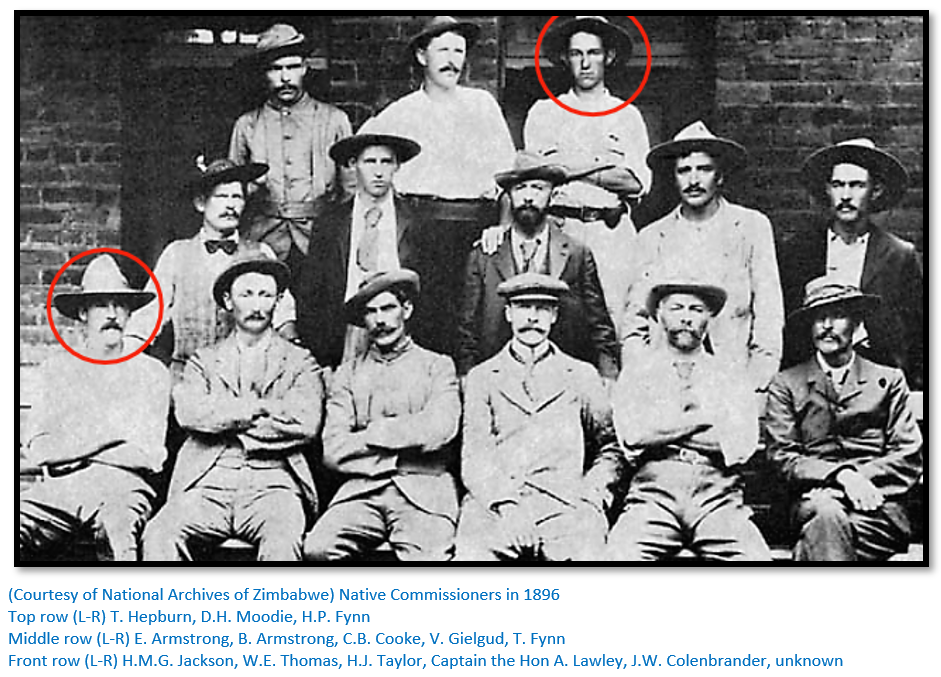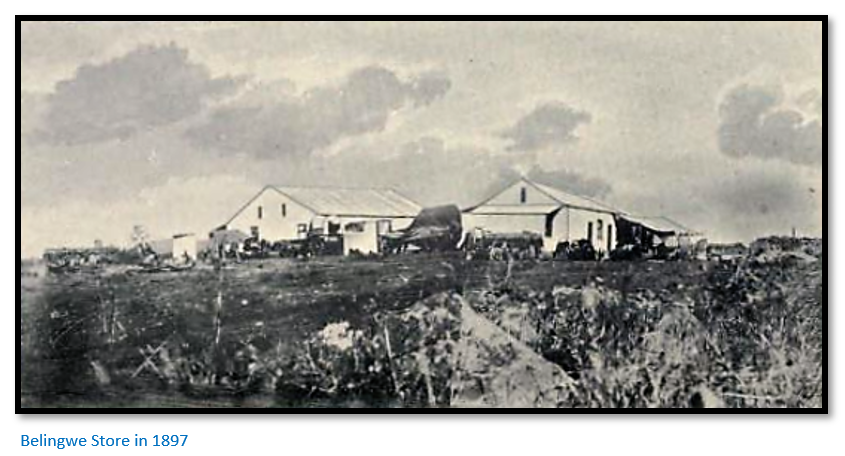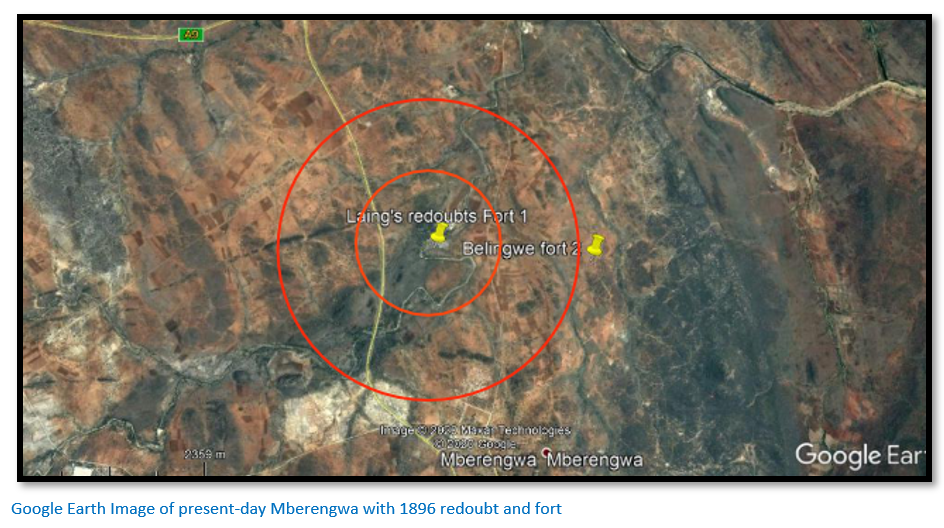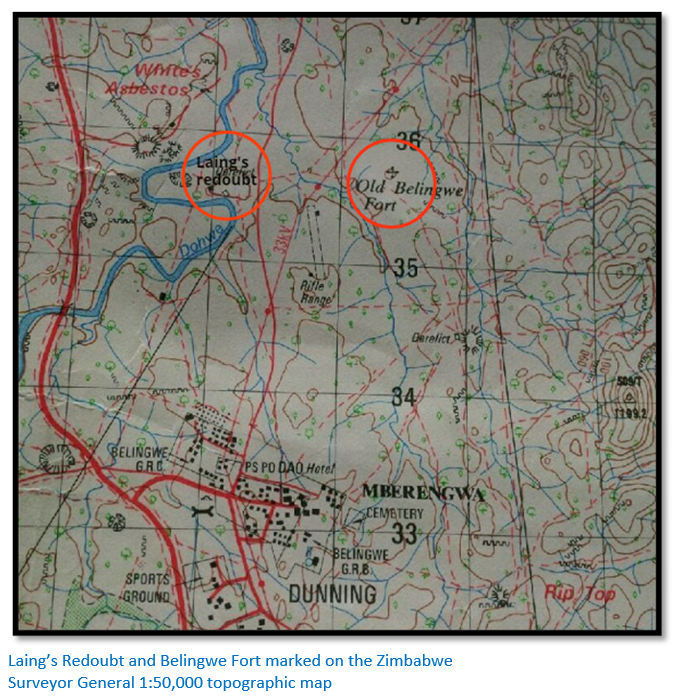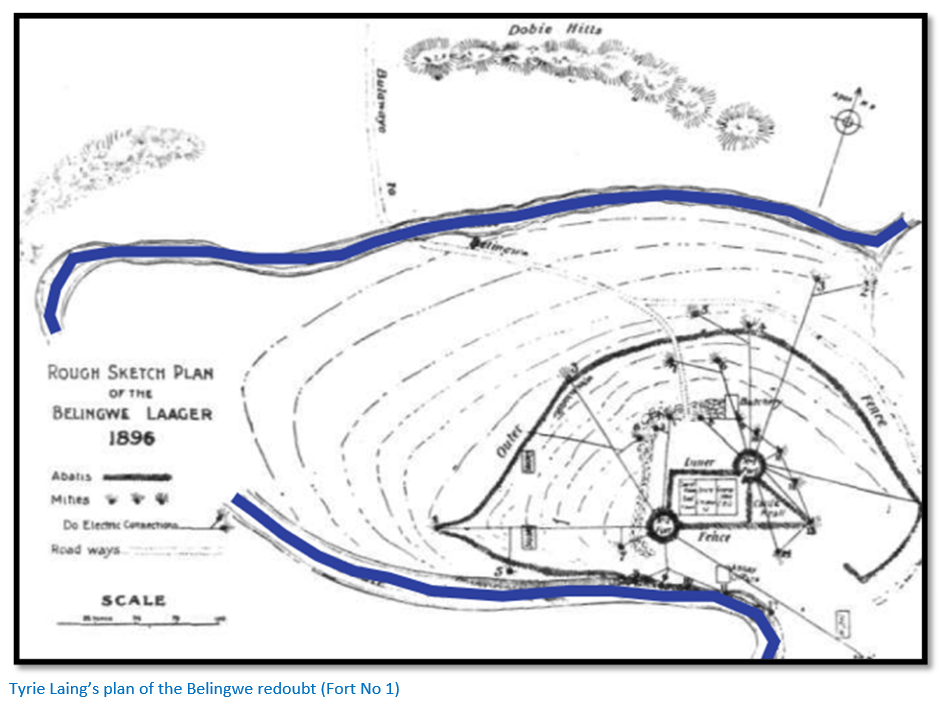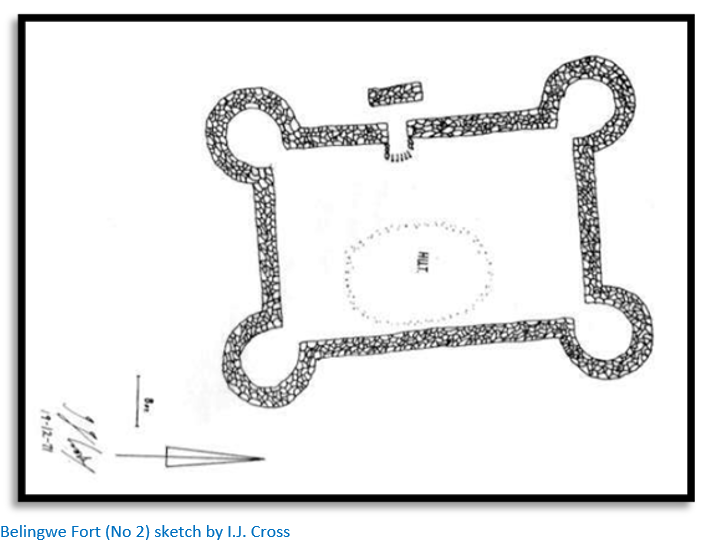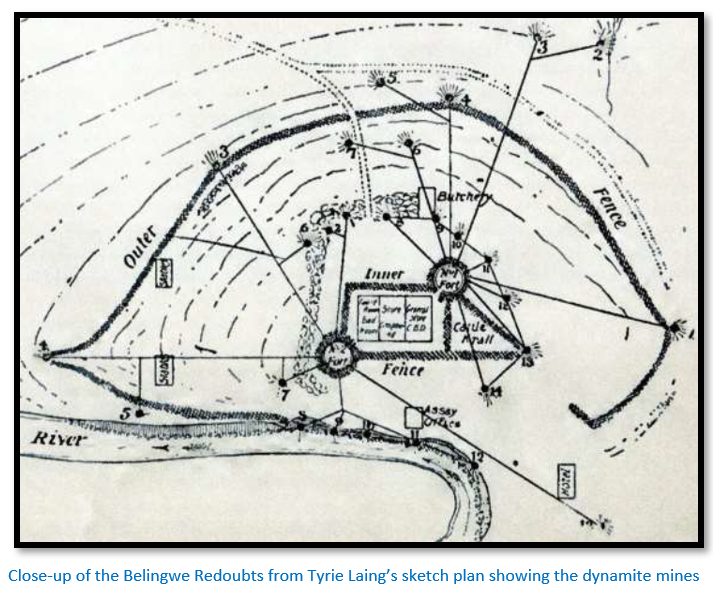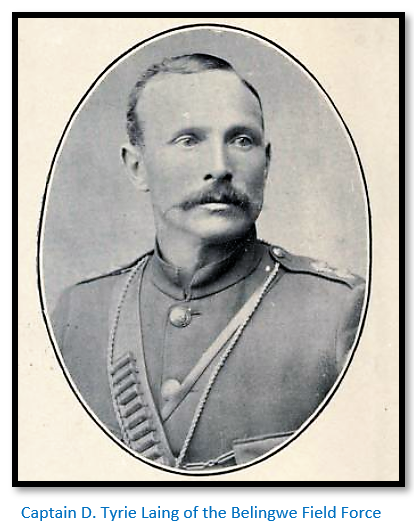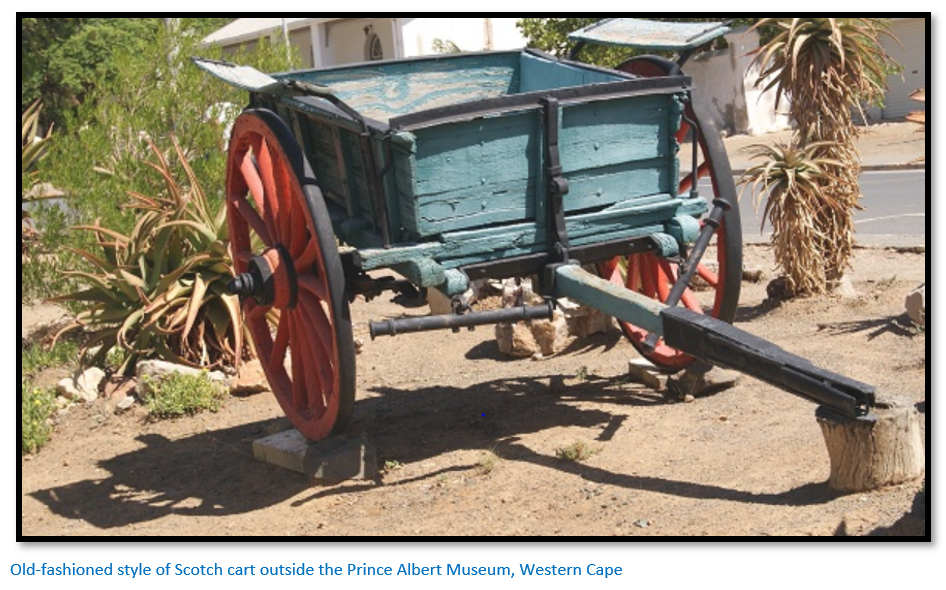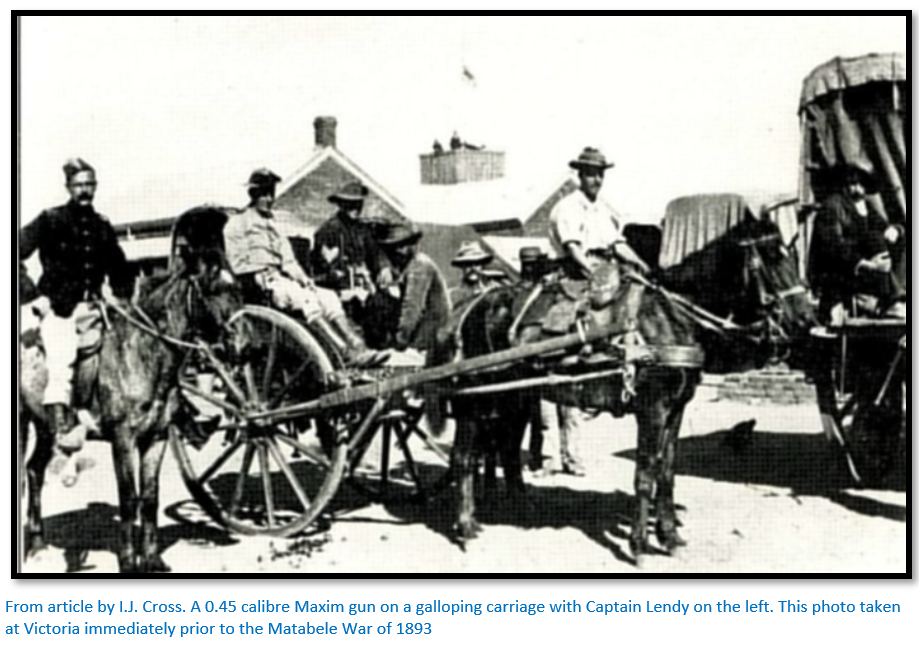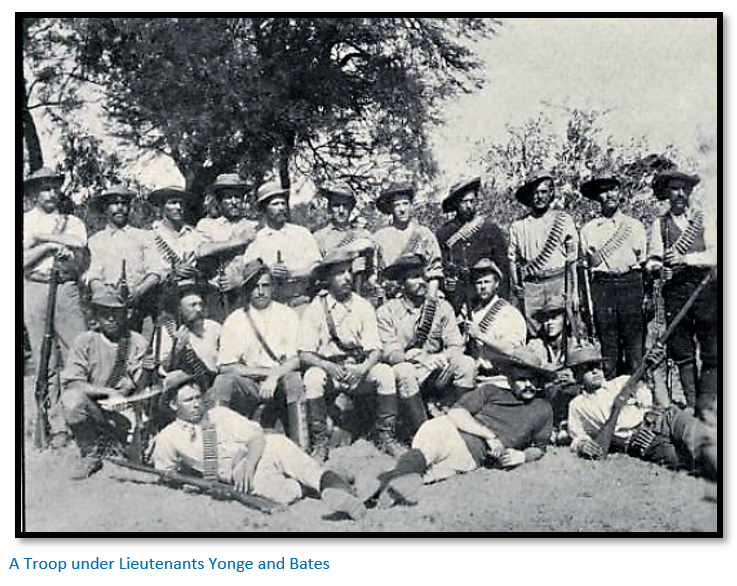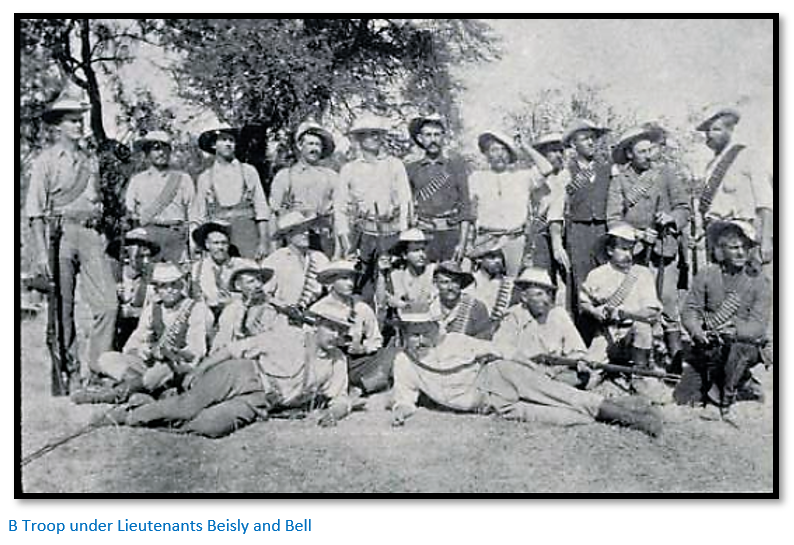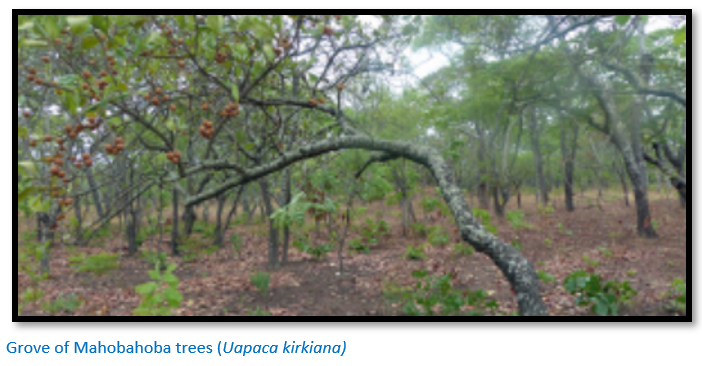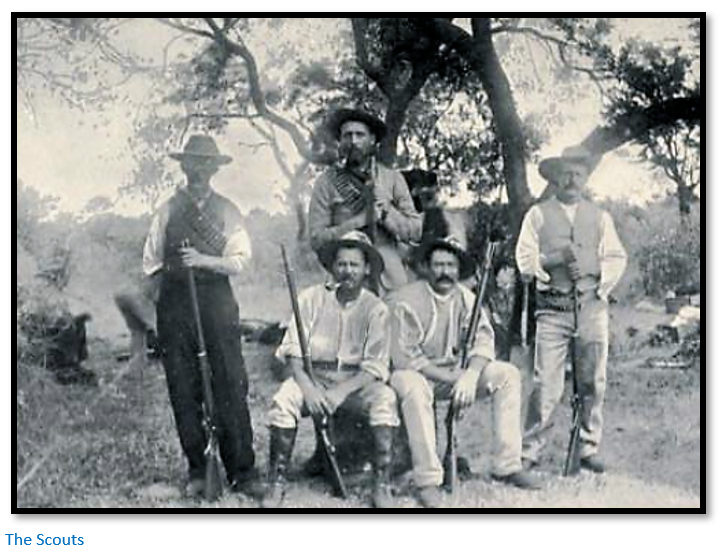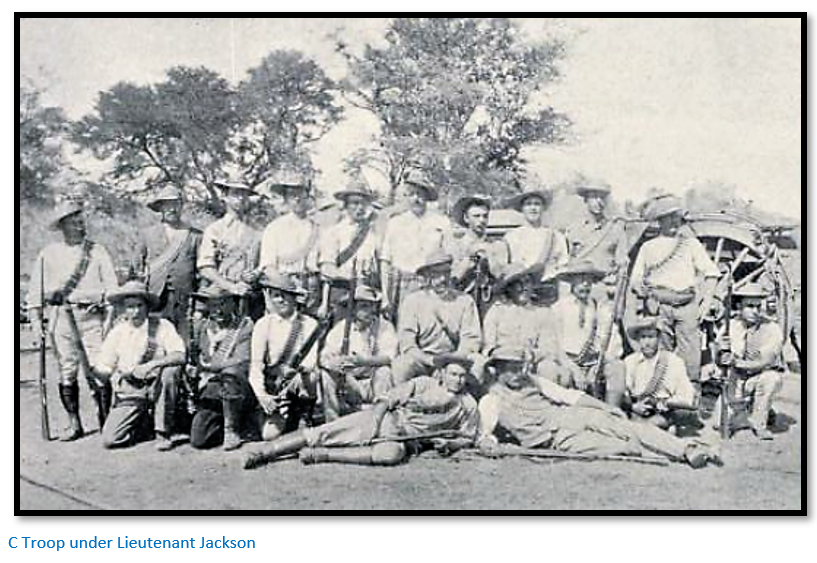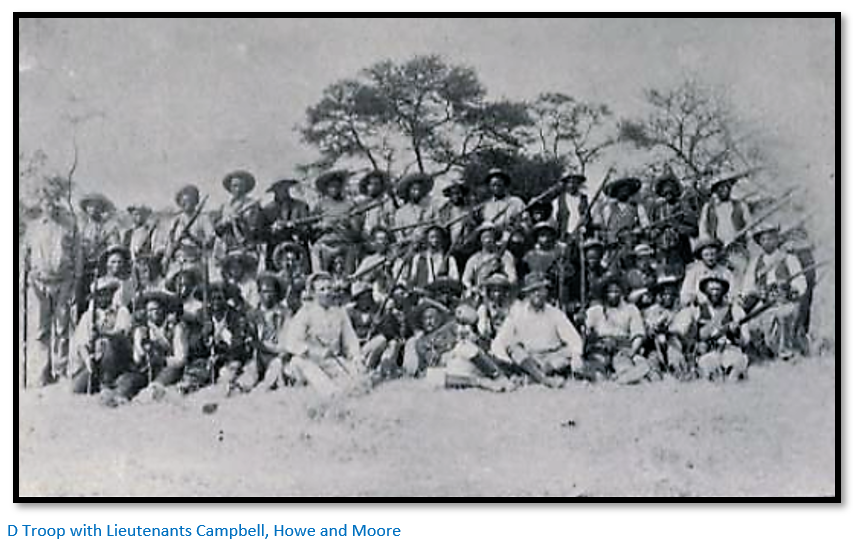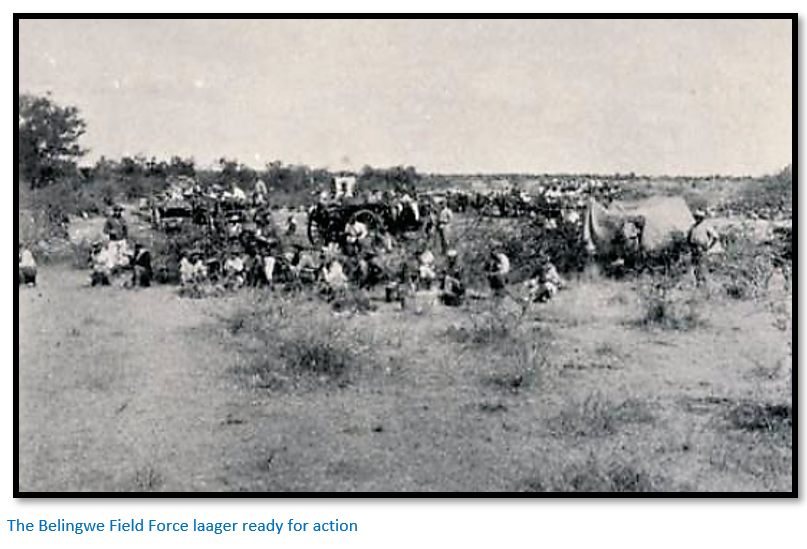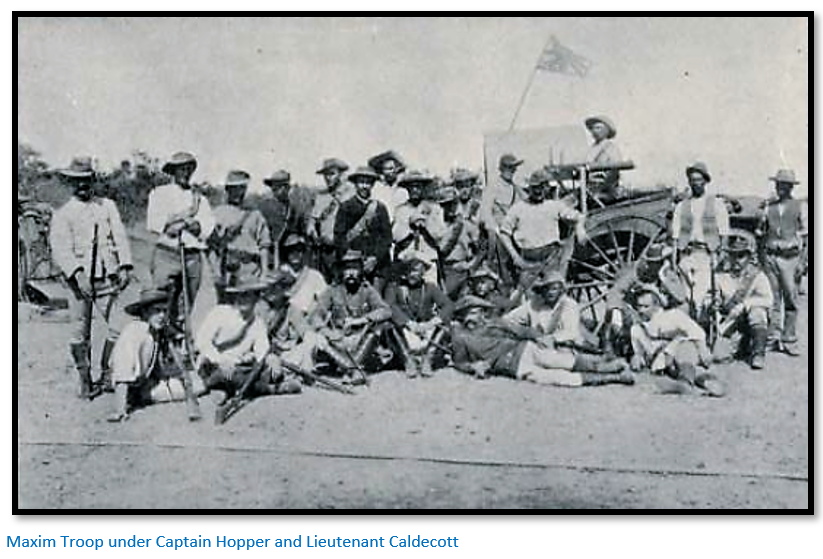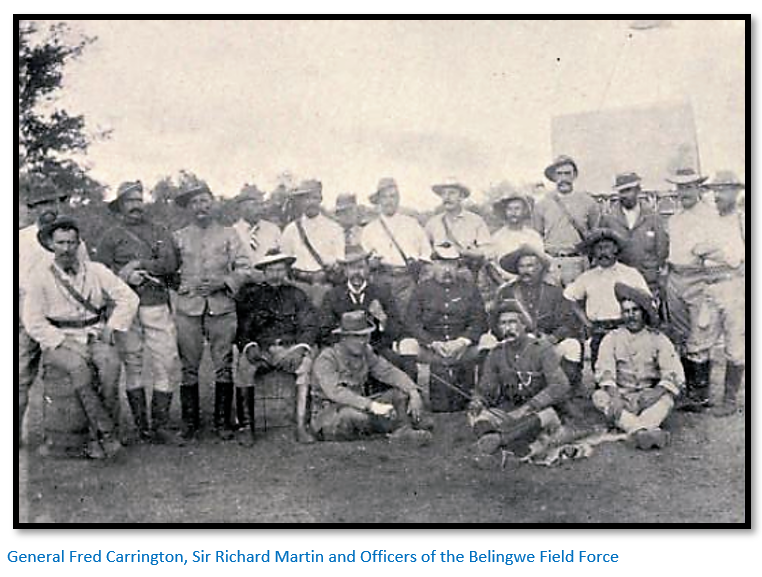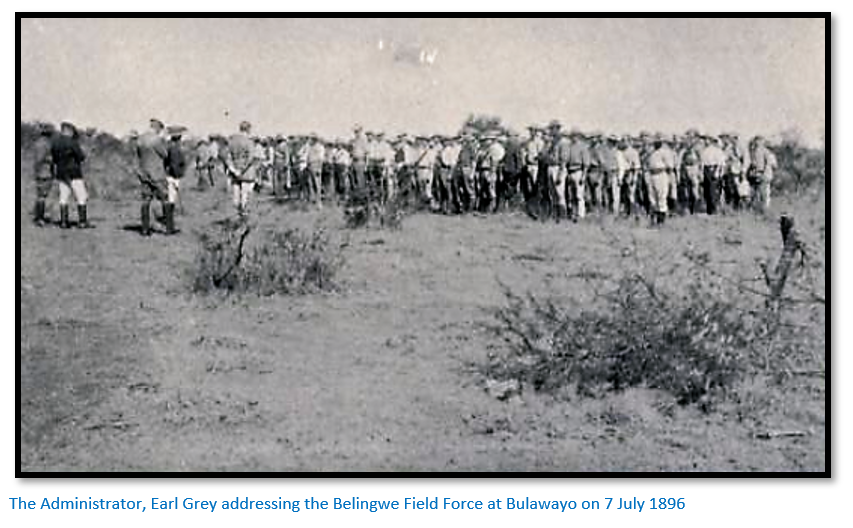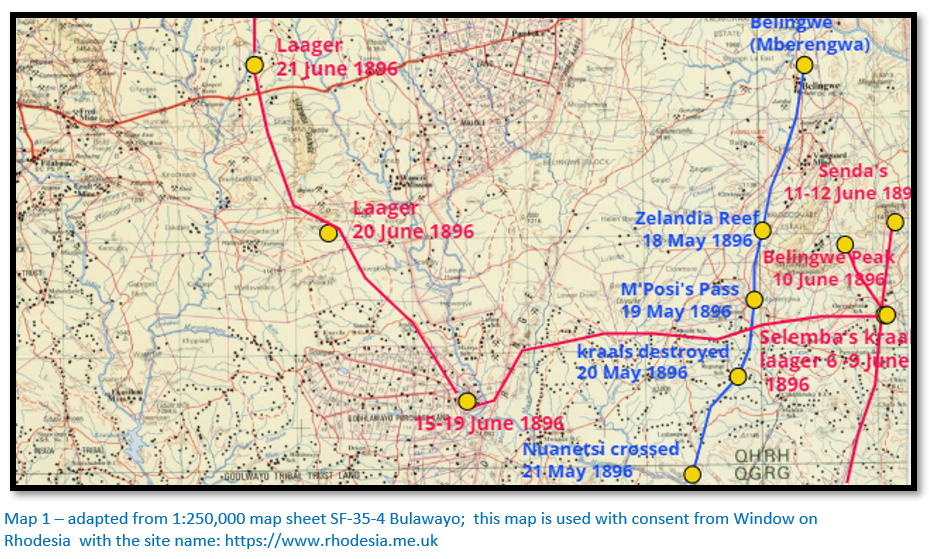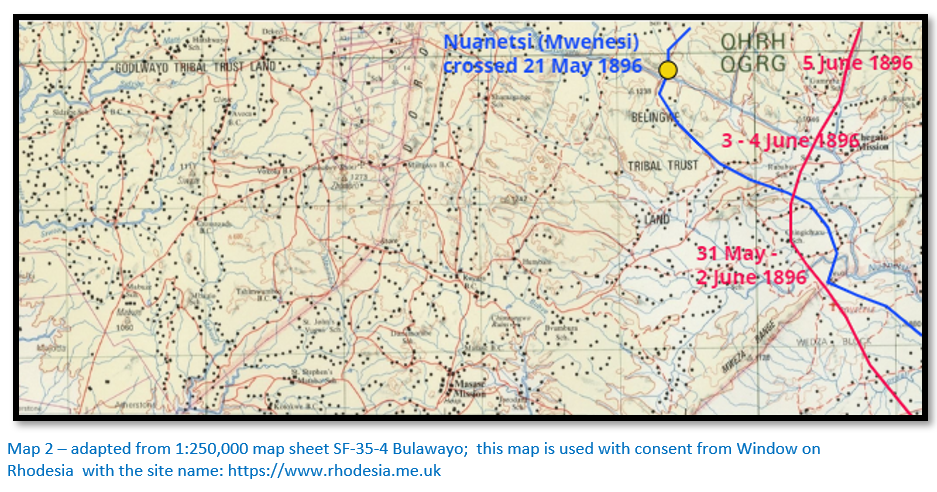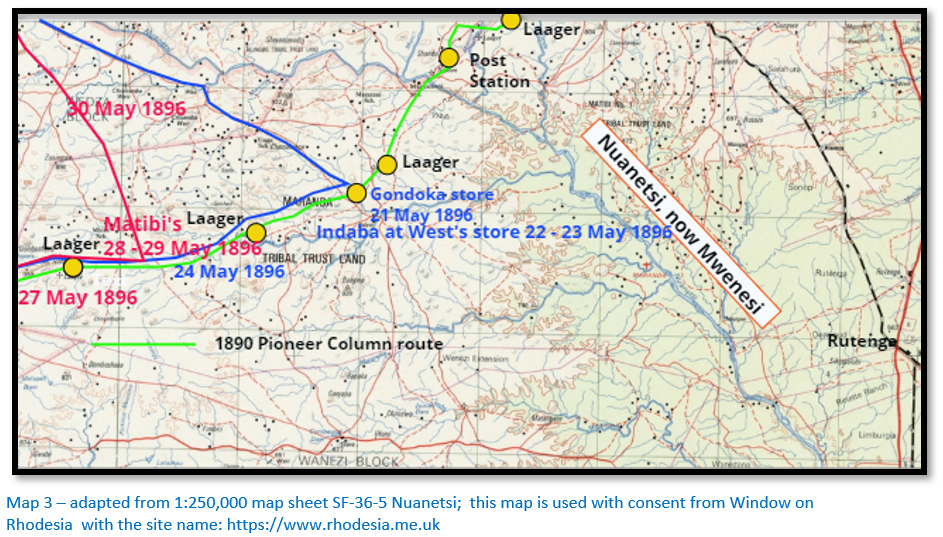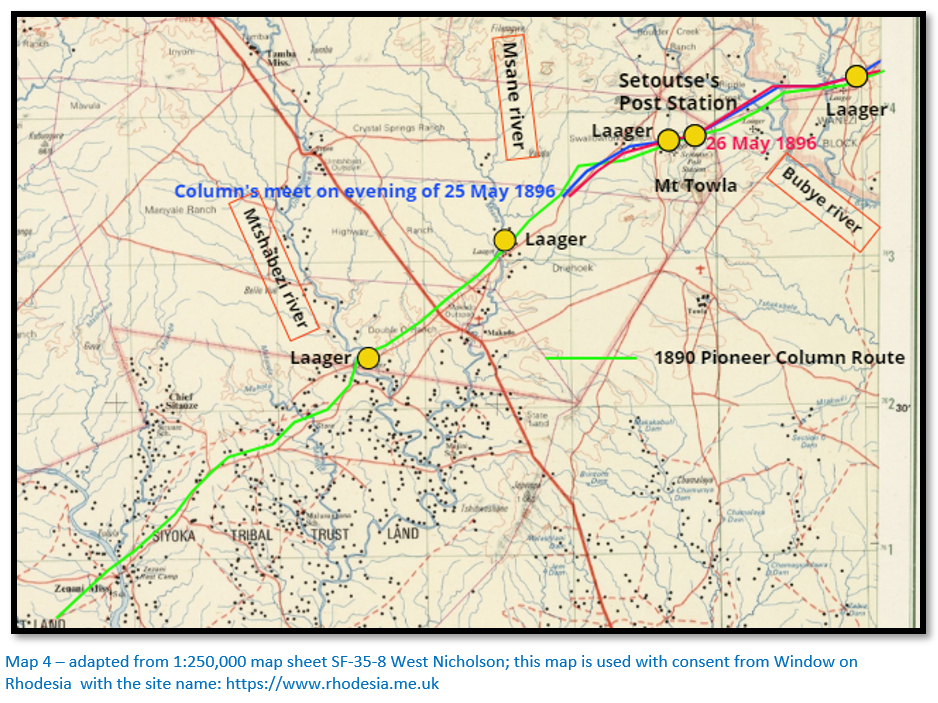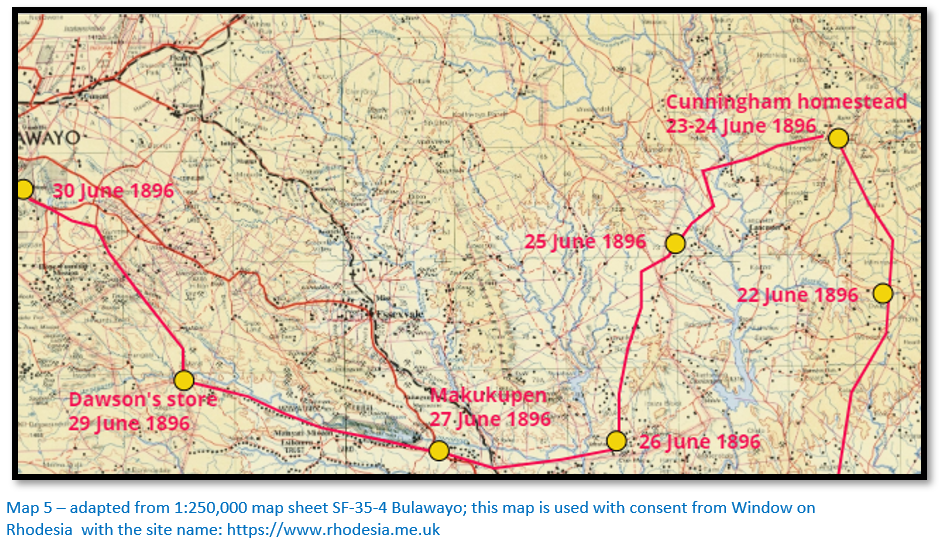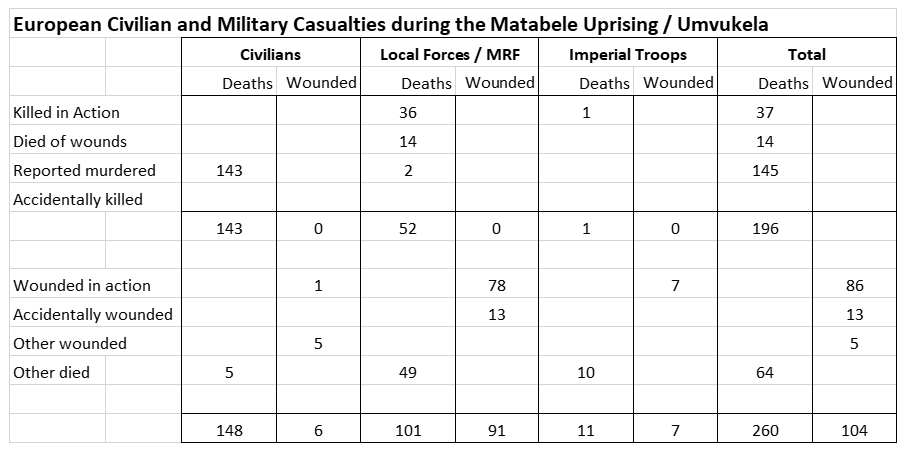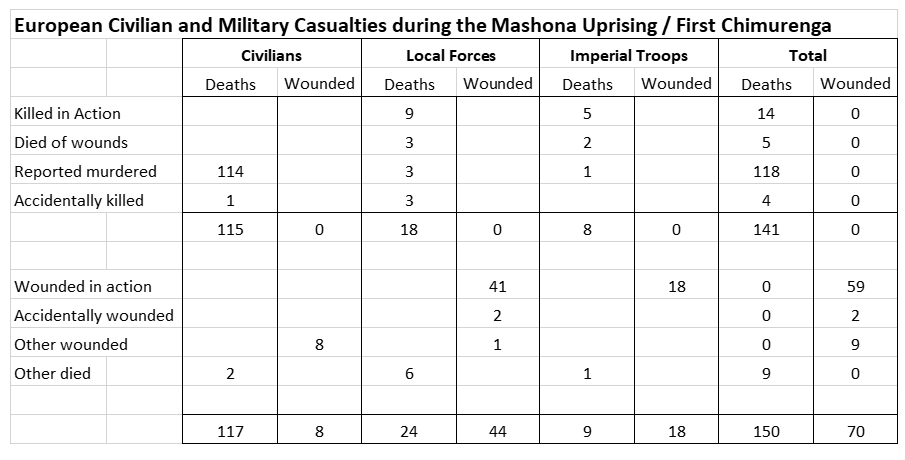The 1896 siege of Belingwe, now Mberengwa as told by David Tyrie Laing
This account from Tyrie Laing’s book The Matabele Rebellion, 1896 with the Belingwe Field Force relates events that occurred from 26 March until 7 July 1896 when the column returned to Bulawayo. A second article will describe events from 12 July 1896 in the Matopos, now Matobo and also give a brief summary of the life of David Tyrie Laing.
Thursday 26 March 1896 - A bolt from out of the blue
Thoughts of danger came very suddenly to David Tyrie Laing (1859 – 1901) whilst he was having an early breakfast with one of his staff, A.J. Wilson.
The Acting Native Commissioner (ANC) for Belingwe S.N.G. Jackson suddenly appeared in a state of excitement saying a native police runner had just brought in a letter from H. P. Fynn, the Acting Native Commissioner at Inseza which read as follows:
Sir,
I regret to have to report to you that the whole of the Cunningham family have been brutally murdered and also Maddocks, manager of the Nelly Reef. Two of his miners got off severely cut about. These two miners tell us that about thirty natives came up to their camp in a friendly way and sprang upon them with kerries and battle-axes. This happened the night before last between six and seven.[i]
All the Europeans in this part of the district have concentrated here,[ii] as things look very serious as regards the natives. All the natives have cleared out of their kraals fearing that the murders having been committed in their district they will be blamed.
It is hard to say whether this organisation has been general throughout the country which I fear is the case. We have received no communication from either Bulawayo or Filabusi yet.
I would advise you to see Captain Laing and get all the prospectors at the Belingwe store until we can get further news. We expect someone over this morning from town.
One of the murderers was shot by the police I sent after them. They came across five of them, all with guns, and that these men were Maholes I cannot believe. That the gang were composed of Matabeles – I should rather think they were Matabeles.[iii]
Coach has not arrived yet.
I have the honour to be, Yours obediently,
H.P. Fynn ANC
The two Native Commissioners who appear in the text above are circled.
A plan of action
They decide the best plan of action is to copy Fynn’s actions at Inseza and get all the surrounding miners, farmers and prospectors in the district to come into Belingwe as quickly as possible without raising the alarm. The ANC Jackson sent out his two mounted European policemen together with several native police with this information and Tyrie Laing sends his engineer, Edwin Valentine out on one of his company’s best horse to call in their miners and at other mining camps.
Valentine’s instructions are to ride as quickly as possible and inform everybody to collect their bandoliers and rifles, load any light equipment onto a wagon, lower any heavy equipment down the mine shaft bringing the ropes away and leave their camps for Belingwe bringing any native employees with them.
ANC Jackson was advised to disarm his native police, but Jackson felt they were loyal. Tyrie Laing did not want to instruct a British South Africa Company (BSAC) official, so left things as they were, but made up his mind to watch the native police carefully.
Tyrie Laing went over to Sir Frederick Frankland’s camp. Frankland was the assistant Mining Commissioner for the Bulawayo district and he and his assistant, W.C. Beaty-Pownall were just about to saddle up and leave to inspect mining properties for the BSAC. They had not heard of the native rising even though they had been two days before at Inseza and Frankland was very upset when he heard the fate of the Cunningham family as he had enjoyed a meal with them. They immediately said they would assist at Belingwe.
A.J. Wilson had gone over to the Belingwe general store and warned all the men there to get rifles and ammunition in readiness.
Tyrie-Laing and Frankland rode over to the police camp but found Jackson had gone leaving W.R. Wilson in charge. They spoke with him about disarming the native police, but he was reluctant to do anything in the absence of his superior.
They rode across to the general store 900 meters (1,000 yards) from the police camp where they found the staff getting rifles and ammunition ready for the men expected from the outlying mining camps. Sites were selected to build fortifications; these were Laing’s Redoubt (Fort No 1) and Belingwe Fort (Fort No 2) and laager defences around the Belingwe Store.
Miners begin to arrive at Belingwe
About 11am Malcolm McCallum who managed the Buluwayo Syndicate rode in having had a note from the police and once the situation had been explained left immediately to bring in his men and supplies.
Shortly after midday Tyrie-Laing’s men from the Bob’s Luck and Wanderers’ Rest came into Belingwe. J.C. Mitchell in charge of Bob’s Luck reported all the native staff had deserted after getting the mining plant under cover and James Louw in charge of Wanderers’ Rest said his native staff had managed to get all the mining supplies down the shaft, but had destroyed all the light supplies before they were loaded onto a wagon and then disappeared.
In the early evening Harry Posselt, W. Lynch and C.F.W. Nauhaus who were farming close to the Doro Mountains about 20 kms (12 miles) away rode in reporting that fifty-six of their trek oxen had been driven away in the night.
At 8pm a meeting was held at the Belingwe Hotel with thirty-six persons present about ten short of those believed to be in the district. Five were at the Sabie Reef 40 kms away (25 miles) and would only arrive the following day, two others at a camp about 5 kms away had dismissed the threat of a general rising, the remainder were expected in next day.
Belingwe placed on active service
Tyrie-Laing was quickly appointed Chairman and read Fynn’s letter and explained all the arrangements that had followed the news.
All were placed on active service status, although this was voluntary and solely for the purpose of protecting life and property. A vote was held with a unanimous decision to place themselves under Tyrie-Laing’s command and to elect Sir Frederick Frankland as a Lieutenant and second-in-command.
Construction of the Belingwe Redoubt
A number of men were detailed to supervise the construction of the two redoubts (Fort 1) by the Dohwe river and Belingwe Fort (Fort 2) by about seventy natives who were in the camp and were told that once the work was completed they were at liberty to stay or leave. Work continued through the night until around 3am helped by a full moon when the walls of the redoubts were well advanced. The natives slept the night in the store paddock with sentries positioned in the best positions for defence. The Europeans slept near the redoubts with their rifles and patrols were sent around the cattle kraals, but nothing disturbed the peace.
To whom do the loyalties of the native police lie?
Tyrie Laing states that ANC Jackson has his police camp about a thousand yards from the redoubt they had fortified. The Google Earth below shows rings around the redoubt at 914 metres (1,000 yards) and 1,830 metres (2,000 yards) As shown below the fort is 2,000 yards from the redoubt and the present-day town of Mberengwa about the same distance.
When morning came ANC Jackson found that during the night the native police had built a bush scherm[iv] between their own quarters and those of their officers. This placed Tyrie Laing and Jackson in a difficult position. For Jackson it raised questions about the loyalty of his native police although they had faithfully carried out all their duties up to the previous day. They were camped about 100 metres from the redoubt and protested they were not part of any rebellion; their officers decided to let them keep their arms but they would be watched carefully.
Preparations to fortify the redoubt continue on Friday 27 March 1896
Next day work continued on completing the redoubts and building a strong external barrier of thorns around the redoubt (Tyrie Laing calls this an abatis on his plan of Fort 1 below) and raising the walls of Belingwe Fort (No 2)
Towards evening W. Sheldrake came into camp and reported that Stoddart’s camp at the Great Belingwe Reef had been looted and nineteen trek oxen taken away. He had been fired upon and Bergqvist had gone to find the missing oxen.
Laing’s Redoubts (fort No 1) were enclosed on all sides except the east by the Dohwe river marked in blue below. In 1972 I.J. Cross said that only one of the two redoubts survived, being 1.4 metres (4 feet 8 inches) high and with a diameter of 6 metres (20 feet) but that it was filled with rubbish. The sites of the other buildings around the redoubt could still be traced on the ground.
Saturday 28 March 1896 – all the native police abscond
Despite being annoyed with Sheldrake and Bergqvist for dismissing early threats of a general rising Tyrie Laing agreed that a search party comprising of W.R. Wilson, H. Posselt, Corporal Daniell, Corporal Le Vierge, H. Paulsen and C. Paulsen could go out and look for Bergqvist.
They left about 6:30am and within 30 minutes of their leaving in walked Bergqvist to report he had followed the spoor of the stolen cattle and come across a party of armed natives who only jeered at him without attempting to harm him. The patrol returned at 1pm to report all the supplies at Stoddart’s camp were scattered over the veld.
Defence works at the store continued and the men were divided into garrisons for Laing’s redoubt (Fort No 1) and Belingwe Fort No 2. Sentries were posted for the night and the native police detailed to guard the cattle kraals. Shortly after sunset shots were fired by the native sentries and when Jackson and his assistant W.R. Wilson investigated the cattle kraals they found that all the native police with the exception of three had deserted taking twenty rifles and ten rounds of ammunition per man. The three native police were questioned but gave no information and after being tasked with collecting mules from Posselt’s farm soon deserted themselves.
Tyrie Laing considers the circumstances around the native police:
- An Inseza native policeman carried the initial message from ANC Fynn of the uprising
- The Belingwe native police at Belingwe took messages to isolated miners and farmers, some as far as 40 kms (25 miles) to warn them to come to safety
Sunday 29 March 1896
The defences are strengthened further and the cattle kraal moved closer to the laager near the Belingwe store. The abattis is completed around Laing’s redoubts (Fort 1) and dynamite mines fired by cable set up.
Belingwe Fort (Fort No 2) is directly east and two kilometres from Laing’s Redoubts as can be seen in the 1:50,000 map section above. In Rhodesiana Publication No 27 of 1972, I.J. Cross in his article on Rebellion Forts in Matabeleland noted that the rough stone walls of the fort were in good condition averaging about 122 cms (4 feet) high, no fire steps were visible and the wall in front of the entrance was tumbledown. The base of a large hut inside the fort was visible with further hut site remains on the south-western shoulder of the hill below the fort and two further hut sites were visible at the foot of the hill on the western side close to the track running to the fort.
H. Posselt and W. Lynch volunteer to ride to Bulawayo
Once it was dark, Posselt and Lynch set off on the best horses to take despatches to Bulawayo to inform the authorities they are safe in Belingwe and to bring back information on the situation in Bulawayo. They rode 80 kms (50 miles) to Inseza which was found deserted. A small laager had clearly been formed at Cummings Store and there were bullet holes in the walls and some dead bodies of natives surrounding the buildings. About 5 kms from Cummings Store they came across the dead bodies of a native woman and child and further on as they approached the drift on the river they were fired upon by native police. Here they turned back as they were clearly outnumbered reaching Belingwe on the Sunday 31 March at dawn.
Tuesday 31 March 1896; information is obtained and volunteers go to Victoria, now Masvingo
Each morning and evening mounted patrols were sent out in different directions and this day a herd boy was caught hiding in the bush. His said that he was one of the herd boys who ran away with the Belingwe native police and helped take Bergqvist’s cattle to Um’Nyati’s. At Um’Nyati’s he heard that an impi would kill all the white men at Bulawayo and then come down and do the same at Inseza and Belingwe and finally go on to Victoria. He had also heard that ten white men had been killed at Inseza but he did not know who was heading the rebellion and reported that Um’Nyati’s men were at their kraal.
This information caused rumours to start swirling around with several of the more nervous men saying they should move to Victoria. Tyrie Laing called a meeting at the Belingwe Store and explained that their position was extremely secure and would continue to be strengthened. He was surprised that any of the men doubted they could hold their current position which was strongly fortified with plenty of water and supplies to last 3 to 4 months. Anyone who felt it best to leave was at liberty to do so but once away from Belingwe they would have to rely on their own resources. If they were forced to relocate it would be to Bulawayo as the road was much easier than to Victoria.
As the meeting ended there were reports that several Europeans were coming in from the bush. They were from the Sabie Reef and had come in slowly using a roundabout route after the native police had delivered the message from Tyrie Laing. They were three brothers, John, James and Archie Cook, Walter Laidlaw and C.C. Pike and all were tired and glad to get into Belingwe.
That evening F. Luckhurst and W. Lyle who had volunteered to ride to Victoria to collect additional ammunition left in the dark on two good horses.
Wednesday 1 April 1896
All the dynamite was moved from the magazine near the store and stored in a mine shaft about a mile away.
Friday 3 April 1896 James Stoddart arrives with news from Victoria
Early in the morning a sentry reported an approaching European that turned out to be James Stoddart who had left Victoria to warn his men at the Sabie Reef. His horse broke down after 50 kms (30 miles) the Sabie Reef he found deserted and walked the remaining 80 kms (50 miles) mostly at night. He arrived footsore, hungry and soaking wet having spent the previous night on a small rise to the east of Belingwe to see if the place was deserted and was happy to see European sentries in place at dawn.
Stoddart reported there were about 120 men and 60 women and children at the Fort Victoria laager. They had 20-30 horses, supplies for at least 6 weeks and plenty of arms and ammunition. Best of all, they were in telegraphic contact with Salisbury and Bulawayo. The rising appeared to be general throughout Matabeleland with the amaNdebele headquarters believed to be in the Matobo. A number of patrols had been sent out from Bulawayo led by Spreckley, Grey, Gifford, Napier and Selous to test the strength of the opposition. The BSAC had ordered reinforcements of 500 men from the Cape Colony. It was believed about 40 Europeans had been killed.[v]
All the men were mustered and Stoddart’s report read to them at 8:30am for which he received three hearty cheers for carrying out this mission and was elected as a Lieutenant. The information was a great relief to all as it showed that the other centres were holding out in defensive positions and would in time go on the offensive.
The muster roll of the garrison at this date and when reinforced a month later is shown as an endnote.[vi] The ten ‘Cape boys’ were armed and did the same duties as the Europeans; the fifteen ‘Zambesi boys’ were used as cattle and horse guards – all played a useful and loyal role.
In the evening a spy was captured inside the sentry lines. He said he had left from Bulawayo three days before with a message from W. Slade to his partner West [Is this the West brothers who were killed at their store at Ntaba-zika-Mambo in late March 1896? See the article Mambo Rebellion Memorial – with three oral history accounts collected by Foster Windram in 1937 and 1938 concerning the killings at West’s store under Matabeland North on the website www.zimfieldguide.com]
The spy continued that the residents at Bulawayo and at Bembesi were going about their normal business. There had been some slight disturbances at Inseza but the native police had put a stop to it. Tyrie Laing says his confident self-effrontery might have misled them if they hadn’t already heard Stoddart’s report. After telling the spy they knew the real situation he seemed slightly non-plussed but was allowed to go free. It seems surprising he was not tried and convicted as a spy at the time.
An automatic sentry is installed at Laing’s redoubt (Fort No 1)
To ensure no further intrusions were made inside the sentry lines a signal-gun was erected on top of the guard house connected to wires in the outer fence, which was divided into seven sections, each with an indicator, which dropped and fired the signal-gun if an entrance was forced. Tyrie Laing states this was so effective it was impossible for anyone to get through the fence and the device enabled them to withdraw seven sentries and lessen the burden of night guards although jackals and other nocturnal wildlife did turn out the guard quite frequently.
Night guards and dynamite mines
The reduced night guards worked out at two hours for each man per night. Three men would be on duty sitting on the ramparts and facing different directions with one on the river bank closest to the southern redoubt. In case they were being watched a full parade of the garrison excepting sentries was held each evening and the full complement of sentries placed. As soon as it became dark however, the automatic sentry was set and the guard reduced.
Twenty-seven dynamite mines were laid at likely places any enemy might concentrate and were attached by overhead electrical wires to each redoubt and they could be fired singly or simultaneously. These were rigged up by John and James Cook; both were electrical engineers.
Saturday 4 April 1896
Whilst the garrison were on parade in the evening two horsemen were seen approaching who proved to be two ‘Cape boys’ sent by Justice Joseph Vintcent the acting Administrator in Bulawayo. He hoped they were alright and requested them to march into Bulawayo after burying all the ammunition they could not carry. After a warm welcome they left the following evening travelling at night and avoiding the main paths with a despatch from Tyrie Laing describing their strong defensive position and the advisability of remaining at Belingwe.
Monday 6 April 1896
Luckhurst and Lyle arrived back from their journey to Victoria with 3,000 rounds of Martini-Henry ammunition and a despatch from Captain Vizard. They reported leaving Victoria on the 3 April with four horses and the ammunition. On the evening of the 5 April they were at the Sand river and had off-saddled and knee-haltered the horses to give them a rest before setting off in the night when two lions scattered the horses. Lyle managed to catch two of them but the other two bolted back towards Victoria. Once the moon rose they loaded the ammunition on the horses and continued on foot non-stop all night and the following day arriving at Belingwe at 4:30pm. They only met Shona natives who were all friendly.
At a full parade at 5:30 pm the despatch from Captain Vizard was read to the men giving details of the rebellion and the efforts being made to put it down and ending with congratulations and giving the Belingwe garrison a free hand to do what they considered best in the circumstances.
The monotony of garrison life
With plenty of ammunition the men were keen to take the fight to the amaNdebele, but Tyrie Laing would not agree to such adventures. The amaNdebele were watching from a hill called Fondoque about 2.5 kms (1.5 miles) from Belingwe and at night large fires could be seen to the north with the mounted patrols often discovering the ashes of small fires at the back of surrounding hills.
Tyrie Laing did not want small patrols getting cut off; he wanted the amaNdebele to get tired of waiting and try and rush their fortified positions. During the day a sentry was posted on a platform raised on the top of a large iron store with a commanding view of the surrounding countryside.
Wood needed to be cut, water was pumped from the river into three iron tanks always kept full. There was plenty of flour to make bread and a herd of over 400 cattle. There was 16 horses, most in good condition and plenty of mealies to feed them and good grazing along the river under the eyes of the redoubt.
With the defences largely complete the natives were paraded by ANC Jackson and it was explained their services were no longer required and they were at liberty to leave or stay. The local natives departed for their homes with the ‘Cape boys’ and ‘Zambesi boys’ electing to stay.
Thursday 9 April 1896
Shortly after dark the sentry issued a challenge; Tyrie Laing and Frankland[vii] rushed out and the sentry stated he had seen natives near the cattle kraal. Jackson, Tyrie Laing and Frankland went to the cattle kraal fence and apprehended a native, the others running off into the darkness where they triggered off the signal-gun before disappearing.
Friday 10 April 1896
In the morning the prisoner was tried by court-martial. He said they came from Chief Wedza’s to take away all the cattle. He admitted to watching Belingwe “to get it when you white men are all dead.” The prisoner was condemned and shot.
At midday three other natives ran away into the veld and were pursued for some distance by the ‘Cape boys’ but got away. Everyone became a little “jumpy” as it was impossible to tell amongst the natives remaining whether they were spies or loyal.
The signal-gun went off the following night, but the cause could not be established.
Sunday 12 April 1896
No drills or fatigues this day with most reading a book or talking to pass the time. About 2:30pm a sentry gave the alarm and reported the cattle herders were running in. The cattle had been grazing about 900 metres (1,000 yards) to the south and a mass of natives were advancing on them. Two horses were always kept saddled and bridled and Sergeant McCullum and Corporal Paulsen rode off to assist the cattle guard. The remaining horses were saddled up and mounted in less than five minutes, by which time a regular fire-fight was taking place with bullets whizzing over the forts.
Tyrie Laing and nine mounted men followed McCullum and Paulsen to where the cattle were being driven off in smaller herds to the south and east. A heavy fire came down from the surrounding hills and from a rear-guard of amaNdebele warriors, but the mounted horsemen formed a skirmishing line and rode straight for the largest herd. The warriors broke away but a few were shot down. The amaNdebele cattle herders were attempting to drive the cattle away as hard as they could go but the cattle kept trying to break back to their usual grazing grounds. Once the amaNdebele fighting men saw the mounted men bearing down on them they became a confused mass, firing off their rifles in every direction and running for the nearest dense bush about five hundred yards away.
Before they reached cover a number of them had been shot, but Tyrie Laing decided against pursuing them further and turned back with the cattle that had been recaptured as he believed this might be a diversionary raid whilst the forts were being attacked. About 190 of the cattle from the herd were immediately recovered although during the night many of the cows came back for their calves.
At the same time it was reported that some of the natives had been signalling in the direction of the cattle before the attack started. At the time it was thought they were signalling for the herders to return. They were all ordered in and those seen signalling pointed out. Three admitted they knew the cattle raid was about to commence and were tried, condemned and shot.
All the natives were then turned out of the forts except those from the Cape, Zambesi or Natal and one Basuto.
McCallum and Paulsen shot three of the cattle raiders before the other mounted men rode up; one was wearing charms and laughed as they rode up shouting that they could not harm him and was hit by three bullets before falling dead. After that the remainder seemed to lose some of their bravado.
Monday 13 April 1896
A severe thunderstorm in the previous evening had obliterated the tracks of the stolen oxen; nevertheless the strongest mounted patrol that could be mustered made a wide detour around Belingwe. The patrol found abandoned blankets, police great-coats and bandoliers filled with ammunition dropped in the veld as their owners had fled for the hills. Unusually, even the dead had been abandoned: “All the dead had a piece of ox fat tied to their throats. This I afterwards learned was fat taken from oxen killed by the Mlimo and given to each man after it had been ‘umtigatied’ [doctored] to render the man impervious to harm from the bullets of the white man.”
Tuesday 14 April 1896
In the morning two of Chief Chibi’s men arrived with a despatch from Captain Vizard at Victoria. They had taken seven days on the road travelling stealthily by night because they were not sure who was friend or foe. They said that Chiefs Wedza, Buschelli, Mapanzula, Mazezeteze, Impopote and Senda were banding together to attack Belingwe and being led by amaNdebele Godhlwayo impi under Maduna, the son of Marqua, Lobengula’s sister. Most of the forces were between Wedza’s and Buchwa Mountain and that the stolen cattle had been taken to the Mpateni Mountains in the Matobo where many of the amaNdebele women and children were hiding. After attacking Belingwe their orders from the Mlimo were to attack Victoria. Maduna was responsible for the killings of white men at Inseza and Filabusi and Um’Nyati’s men were all armed and at their kraal.
Chibi’s men were nervous of staying any longer so they were given a despatch for Captain Vizard and left in the early evening. Several hours later the sentries reported movement and the two men were back. They had come into contact with a body of amaNdebele, some in police great-coats who gave chase so that Chibi’s men fled back to Belingwe losing their blankets and the despatch which was re-written and the men left in the dark by another route.
Wednesday 15 April 1896
One of Carruthers’ servants came from Gondoque[viii] 113 kms (70 miles) south of Belingwe with a letter for Lyle requesting a rifle and ammunition and asking for information. He left with a letter only saying that Carruthers should go to Victoria, which in fact he did.
Sunday 19 April 1896
Trooper Roodts was showing the action of Sgt McCallum’s Winchester repeater to his comrades when the rifle went off, the bullet grazing Trooper Yorke’s hand and entering the leg of Trooper Beaty-Pownall. Tyrie Laing at once cleaned and bandaged the leg. “He was a splendid fellow and a great favourite in the garrison.”
Sunday 16 April 1896
Trooper Bergqvist had been suffering from fever and died at midday after choking on some food. Soon after Mrs Mitchell, the wife of J.C. Mitchell also died from the combined effects of fever and shock. Both were buried next day in a small clearing about a hundred yards from the fort. Fever was at the time widespread with as many as seventeen Troopers unfit for duty.
Tuesday 28 April 1896
Due to discontent amongst the men they were all paraded and Tyrie Laing had to tell them that if anyone were found deliberately shirking his duty they would be court-martialled.
The same morning Beaty-Pownall asked for his leg to be amputated and this procedure was discussed with Frankland, Stoddart and A.J. Wilson before Tyrie Laing carried out the procedure despite only having done a short course in surgery. For the first few days the leg healed well, but on 2 May 1896 he died in his sleep and was buried with military honours beside the other victims. “This was one of the heaviest blows our little garrison had to sustain.”
Friday 1 May 1896
Stoddart and H. Posselt volunteered to ride through to Bulawayo with despatches and bring back any information on the state of affairs. They took three of the best horses and left at midnight on their hazardous ride and planned to avoid the main footpaths and rest up during the day.
Monday 4 May 1896
Two native messengers arrived from Victoria. One message was from Cecil Rhodes congratulating the Belingwe garrison and saying he would help in any way he could and that any messages for him should be sent to Gwelo, now Gweru. The messengers brought the news of a series of successful engagements outside Bulawayo, that the Godhlwayo impi composed of approximately 500 warriors was camped close to the main road near Senda’s kraal but did not intend attacking again.
Tuesday 5 May 1896
The two messengers left for Victoria with despatches for Captain H. Hopper now commanding the Victoria garrison and Rhodes saying the Belingwe garrison was doing fine and that any reinforcements from the south should be sent to Belingwe rather than Victoria as it was much closer to the rebel strongholds and with advice on which roads to take.
Two of the ‘Cape boys’ volunteered to ride to Gwelo. Harry Pick knew the road well and with his comrade September had two good horses and left after dark. The journey took three days and was hard going; they were nearly captured close to Selukwe but shot seven of their most persistent attackers.
The same night about 11pm Stoddart and H. Posselt returned to Belingwe. They had got as far as the coach stables at Thabas Induna, now Ntabazinduna where they were encircled by a large group of armed warriors. They retreated back to the Selous road but were hotly pursued the whole time and compelled to return on the Belingwe road. At Graham’s store they could see the remains of a small laager and signs of a fight with empty cartridges lying about. They could only cross the drift on the Inseza river in the dark and reported that Cumming’s store had been burnt down and sixteen donkeys killed and the coach stables at Malomachopie had also been destroyed.
Wednesday 6 May 1896
Two native messengers came in from Captain Hopper saying they were on the way with twenty mounted men, a Maxim gun and two Scotch carts carrying supplies and 15,000 rounds of Martini-Henry ammunition.
This good news was welcomed by all at Belingwe; Captain Frankland was sent with a small patrol to help Hopper’s party over the Umchingwe river which had a difficult drift and some fresh oxen.[ix]
Thursday 7 May 1896
Hopper and the Victoria party which included Dr Anderson came in after midday and were welcomed with three cheers by the Belingwe garrison. The full list of those under Captain Hopper are included below.
Most of the Victoria horses were salted[x] and additional and wider-ranging mounted patrols were sent out to scour the neighbourhood, but no amaNdebele were found within 20 kms (12 miles)
Monday 18 May 1896
Two despatch-runners arrived with the following message from Rhodes:
Please ride down to Tuli to meet column coming in, a portion having instructions to detach themselves from Victoria column and place themselves under you and to be led by you to Belingwe via Gondoque to act under you as you deem best.
A patrol of fifteen mounted volunteers with the Maxim drawn by two mules with two horses as leaders was quickly assembled and they left at sundown leaving Captain Frankland in charge of Belingwe. By 10pm they were at the foot of Belingwe Peak where they camped on the mine workings of the Zelandia Reef.
Tuesday 19 May 1896
After a quiet night they saddled up at 4am and were another 20 kms (12 miles) further by 8am before stopping for breakfast. They were through what Tyrie Laing thought was the most dangerous part of the journey and fresh footpaths leading to Belingwe Peak led him to conclude that was where the local natives were in hiding.
They rode on from 10am to midday and were on the ridge leading down an incline into the Mapelabana hills when they came upon Chief M ’Posi’s people collecting maize. The troops formed a skirmishing line with the Maxim in the centre and advanced but as soon as they were seen the local people took off into the bush but not before one man was taken prisoner. He told them the
Godhlwayo impi was still near Belingwe, that Chief M ’Posi was at home but sick and that the local people were friendly.
This statement had previously been corroborated by Carruthers who said the local people warned him not to go to Belingwe and gave him food for his journey back to Gondoque. He had got back, but had his rifle stolen from him whilst drinking water from a kraal some 15 miles further on. Carruthers had been chased for ten miles but managed to slip away into the dense bush when it became dark.
The patrol then continued south towards the Mapelabana hills but the going became slower as the track was now steep and flanked on either side by thick bush.
They stopped to give the horses a rest and drink in a small rivulet and the men a coffee break and Tyrie Laing spoke to H. Posselt, Lynch, Lyle and Carruthers who were all familiar with the area and spoke the language of the local people. They believed M ‘Posi was loyal but were puzzled and becoming suspicious by the behaviour of the tribes people who were not approaching closer than 500 yards and appeared armed on the surrounding hills.
Shortly after Chief M ‘Posi’s son made a hesitant appearance but was persuaded by H. Posselt to meet Tyrie Laing and when questioned said that they had heard many conflicting reports and were under the surveillance of the Godhlwayo impi lying close at Belingwe Peak. He said his father was sick but would come and speak with them at this place next day and that they were quite safe. Posselt said the young man had worked for him and he thought he was lying but was not sure why. Tyrie Laing thanked the Chief’s son saying he was glad they were staying loyal and this would be remembered and the Chief and his tribe should not be afraid as they would not be harmed.
No action would take place amongst M ‘Posi’s tribesmen until an indaba had taken place so the patrol moved off down a steep gorge about 180 metres (200 yards) wide with high granite sides and thickly wooded. It was an ideal place for an ambush and every trooper had his rifle at hand and the Maxim belt was fitted and ready for action. Tribesmen watched their progress from the heights but no effort was made to interfere and once out of the gorge camp was made alongside a large antheap which was levelled at the top to take the Maxim and a defensive trench built around it. The horses were picketed inside the trench and a strong thorn hedge built further out each man carrying an axe so that the construction took just 30 minutes.
They were just settling down before sundown, the men had eaten and had a coffee preparatory to stretching out for the night when there was the sound of voices approaching. Upon challenging the approaching natives two came forward and turned out to be Chief M ‘Posi’s son with whom they had talked to earlier and his brother, just back from Kimberley and dressed in a yachting suit and straw hat who spoke good English.
The son commenced by sending his father’s greetings and that he was pleased the white men were leaving Belingwe as the amaNdebele were now seeing nothing but blood and that having seen the patrol pass they would soon be on their trail. Tyrie Laing replied that they would be back and he expected to see two wagon-loads of grain ready for them to collect on their return which of course they would be paid for. The son replied that he would carry the message to his father and the grain would be ready. The patrol however were left with an uneasy suspicion which was confirmed by the buzz of voices late into the night coming on the wind from M ‘Posi’s kraal.
Wednesday 20 May 1896
Next morning before dawn the horses were fed and the patrol moved off at a brisk canter.
Soon they were approaching Dooboolelo’s kraal whose people had tried to kill Carruthers. They approached cautiously through thick bush after leaving the main track and rode towards the kraal which was sited in a good defensive position under granite hills. One tribesman with a rifle and assegais was killed before Posselt, Lynch and Carruthers called out to the chief to come down and speak.
He refused to do so and was given an hour to reconsider whilst the patrol had breakfast and then burnt down the kraal. Dooboolelo was an amaHole called Maholi by Europeans[xi] and had been an honorary head of one of Lobengula’s regiments. He was clearly opposed to Europeans and supplying grain to the amaNdebele and so any his kraals encountered were burnt down. Nightfall saw the patrol camped about 11 kms (7 miles) from the Nuanetsi river.
Thursday 21 May 1896
By 9am the patrol had crossed the Nuanetsi river on a drift and was having breakfast on the south bank. They left at midday arriving at Gondoque[xii] at 3pm Tyrie Laing states it was on the Pioneer Column Road and 116 kms (72 miles) south of Belingwe. Chief Matibi[xiii] was friendly to the BSAC and two of his tribesmen took the patrol by a short cut to Gondoka store. West’s storekeeper was present, but there were few supplies due to the disruption of traffic which was a disappointment to the men of the patrol.
Friday 22 May 1896
M’kati, one of Chief Matibi’s sons arrived early in the morning and was asked to request the headmen of the surrounding kraals to an indaba which he promised to do. The patrol then moved their camp to West’s store using its verandah for shade and the horses were released to browse.
Umshete, Chief Matibi’s eldest son arrived and said they had no news of a column coming up from Tuli but volunteered to send six of his men down the road with a despatch from Tyrie Laing.
Saturday 23 May 1896
Local tribesmen brought in gifts of mealies and sweet potatoes which were welcomed by the men.
Sunday 24 May 1896
Umshete with M’kati returned to West’s store and said they had been instructed by their father Chief Matibi to take part in an indaba. They wished to say they had always been friendly to the BSAC and the white people and had tried to give assistance in the 1893 Matabele War and had gone as far as Godhlwayo to recover the coach mules which had been taken by the amaNdebele.
Umshete said that they knew Carruthers, Lyle and H. Posselt and that the last had told them the white men were angry because they had given no information. Chief Matibi had said they must tell everything they know at the indaba and give the white soldiers all the assistance they could.
The sons then said that several tribesmen had been with the amaNdebele near Mt Wedza [approximately 60 kms 37 miles north of Belingwe – See the article Baden-Powell in Matabeleland in 1896 where he learned the principles of scouting under Bulawayo on the website www.zimfieldguide.com] where one impi was concentrated. They had ordered all the maize to be reaped and stored in the Wedza hills near Nyamande’s kraal. Nyamande was an amaHole (Maholi) and an agent of the amaNdebele.
The other much stronger impi was in the Mapelabana Mountains south of Belingwe with many of the women and children. The women at M ’Posi’s kraal were reaping in the maize in case it is needed by the amaNdebele in the Matopos.
They reported the amaNdebele as saying they will fight the white men in the Matopos. If they are beaten one impi will retreat down the Gwai river into the thick thorn bush country of the Zambesi valley. The other would retreat south west through Mapelabana and Wedza Mountains with the cattle into Gazaland and that is why the women and children were staying in these mountains.
Tyrie Laing thanked the chiefs’ sons and requested that when the column came up they make available 300 fighting men. Tyrie Laing says the indaba broke up with the young men going to their different kraals evidently delighted at a chance to fight their old enemies.
As the six men of Chief Matibi had not returned with news the patrol left Gondoka at sunset taking the old coach road towards Tuli. Three miles down the road the pole of the Maxim carriage broke and a new one had to be cut and fitted.
Here they met two of Matibi’s men who had been as far as Goma about 48 kms (30 miles) further along but had not seen the column. However they reported two Basuto police working for the BSAC had told them a column of thirty wagons and many soldiers had left Tuli for Bulawayo the day before. The patrol camped after 10:15 pm for the night.
Monday 25 May 1896
They started off before sunrise and arrived at the Bubye river after 8am and stopped on the river bank to give the horses some grazing. The men were now short of food and the countryside deserted. They resumed the march at 4:45 pm and Tyrie Laing hoped that with three long marches through the night they might get within 30 miles of Tuli.
Towards sunset the advance files signalled a halt and reported fresh tracks of two horses on the road. The march was resumed until 6:45 when a halt was made. Then they heard very faint voices and moved cautiously forward before seeing camp fires. Suddenly they were challenged by English voices and eight troopers showed themselves on both sides of the road as they identified themselves.
They reported they were an advance patrol of twenty scouts under Natrass and had camped at this waterhole and were about 13 kms (8 miles) ahead of the main column.
The patrols merged with everyone seeing a familiar face and catching up with the news. Tyrie Laing says many were the questions asked and answered around the camp fires that evening and many a strong expression escaped someone’s lips when the brutal murders of old friends, women and children were described.
An hour after the initial meeting Captain Brabant with Lieutenant Yonge rode in. Younge said the column had been delayed at Tuli by horse-sickness amongst the horses and mules. Brabant had ridden 270 miles in less than 9 days from Bulawayo via Mangwe, Semokwe and Tuli with despatches from Earl Grey, the Administrator.
The despatches gave Tyrie Laing overall command of the column from Lieutenant Yonge[xiv] and to use it to the best advantage in quelling the rebellion. Brabant was to remain with the column and organise any native levies they might raise.
The list of those missing and confirmed killed was much greater than the Belingwe garrison had at first supposed and Tyrie Laing says that to say they were shocked would be putting it mildly.
Tuesday 26 May 1896
Next morning the combined relief column arrived at Setoutse’s, a post station a few miles west of the Bubye river. The combined strength was 150 mounted Europeans, 70 ‘Cape boys’ of D troop, 150 horses, 25 wagons and 350 mules. The mules thanks to Doel Zeederberg were in first-class condition, but the horses were a mixed lot and many in poor condition. The wagons had supplies and ammunition and eight wagons were for Victoria.
The men were divided into the following units:
| Officers | NCO's | Troopers | Horses | Mules | |||
| Staff | Captain Tyrie Laing | 3 | 3 | 8 | |||
| Maxim Troop | Captain Hopper | 2 | 2 | 26 | 30 | 4 | |
| Lieutenant Stoddart | |||||||
| A Troop | Lieutenant Yonge | 2 | 2 | 26 | 30 | ||
| Lieutenant Bates | |||||||
| B Troop | Lieutenant Beisly | 2 | 2 | 25 | 29 | ||
| Lieutenant Bell | |||||||
| C Troop | Lieutenant Jackson | 2 | 18 | 2 | |||
| D Troop | Lieutenant Campbell | 3 | 5 | 60 | 4 | 224 | |
| Lieutenants Howe and Moore | |||||||
| Scouts | Lieutenant Lynch | 1 | 2 | 4 | 10 | ||
| Remount Officer | Lieutenant Chivers | 1 | 1 | 2 | 35 | 20 | |
| Quartermaster | Lieutenant Lichtenstein | ||||||
| Native levies | Captain Brabant | 2 | 2 | 330 | |||
| Lieutenant H. Posselt | |||||||
| Troopers Carruthers and Southey | |||||||
| 16 | 21 | 491 | 148 | 248 | |||
In the afternoon Brabant, H. Posselt and Trooper West rode on to Matibi’s to talk with his sons.
Wednesday 27 May 1896
The reorganised column crossed the Bubye river to the east bank. The afternoon’s march took them over the Bubiana drift and to the west bank of the Umquqe river.
Thursday 28 May 1896
In the morning Chief Matibi’s was reached and a laager formed by 8am. The men were drilled and had rifle drill while Brabant had further discussions with Matibi’s sons who he believed were loyal and friendly. The eight wagons and escort under Captain Sporssell continued on to Victoria.
In the afternoon Umshete arrived with ‘May’ who had military service with the British in Zululand and Basutoland and spoke English saying: “This man will represent me as I am too old to go to the front myself. He will lead one hundred of my young men, but M’kati, my brother, will have the supreme command of all Matibi’s men under you…They will all be here before midday tomorrow.”
That night there were beacon fires lit from every hill in the district.
Thursday 28 May 1896
Soon after sunrise the men practised skirmishing drill and at 11 am targets were put up for shooting practice. All the while Matibi’s men were coming in small detachments, some armed with Martini-Henry’s, others with Enfield’s, assegai’s and battle axes.
At 2pm M’kati turned up in an old frock coat, silk hat and strong walking stick. When asked how he felt about fighting the amaNdebele he replied: “If you will only let us fight when we get to them you will be able to form your own opinion as to our likes and dislikes. All I can say at present is that my people and myself have every reason to hate the Matabele. They have been our mortal enemies for years and we only wish to have the chance of paying them back in part for the harm they have done us on several occasions.”
In the evening a meeting took place to decide the best route back to Belingwe. The way they had come down through the Mapelabana Mountains was the only route used by European traders to bring in their wagons and would now be blocked by the amaNdebele Godhlwayo impi. M ’Kati’s men said they knew a more direct route along which some wagons had already travelled and they could cut trees and clear the road if necessary. This track was twelve or fifteen miles east of the previous road which shortened the route to Belingwe and would catch the amaNdebele by surprise as they would be watching the other road.
In addition M’kati sent off about twenty of his men to act as scouts and spies to misinform the amaNdebele as to their plans and route. They should exaggerate the size of the eight wagon convoy heading for Victoria and as Matibi’s country extended as far as the Nuanetsi river the amaNdebele would be ignorant of their initial movements.
Lieutenant Lynch and the scouts left with Captain Brabant and about 50 of Matibi’s men to clear the proposed route.
Saturday 30 May 1896
The march began at 6:30 am and the Umchime river was soon reached close to Sekombi’s kraal who came out to greet them and told them that the previous day five amaNdebele scouts armed with Martini-Henry’s had come close to his kraal seeking information on the soldiers. Sekombi said they were told they had all gone to Tuli and the amaNdebele left going in the direction of M ’Posi’s kraal who was known to be allied to the amaNdebele and who had now blocked the pass that Tyrie Laing’s patrol had passed through. Sekombi added that had they waited a few more hours at M ‘Posi’s pass they would have been surrounded; they had in fact been followed until the amaNdebele heard the Maxim firing at Dooboolelo’s kraal. They were unaware the patrol had a Maxim but now they knew they have set ambushes along that road. Sekombi said he could not let them have men as his position was not strong and they would be sure to be attacked if the amaNdebele knew they had helped the soldiers.
The column moved on and laagered on the north bank of the Matope stream.
Sunday 31 May 1896
Scouts were sent out and just before setting off three of M ’Kati’s men came in to say M ’Posi’s men and 200 amaNdebele were waiting in ambush at M ‘Posi’s pass for the column. A patrol was sent in the direction of M ‘Posi’s to mislead them but the main column continued over the Mwesa range and laagered until the scouts returned. They had seen no signs of amaNdebele and so the column continued until they reached a good position and laagered again. Patrols were sent out to set fire to any local kraals and provoke an attack.
The native scouts were pursued back to the laager but the impi gave up the pursuit when they saw they faced not twenty soldiers but a much larger column.
Wednesday 3 June 1896
The column moved from its position east of the Nuanetsi river to about 2 miles south of the entrance to the pass. This area was rich with native gardens and Tyrie Laing wished to stop food being taken to the Matopos and provoke the amaNdebele into an attack on his strong position. Towards midday the sentry outposts reported a large body of natives on a flat hill two miles east of the laager. Through binoculars about 300 armed warriors could be seen and their numbers grew through the afternoon.
However it became clear they did not wish to attack the laager but the sentries were extra vigilant that night.
Thursday 4 June 1896
At 4am Captain Brabant and the native levies together with A Troop under Lieutenant Yonge advanced towards the enemy position but were too late to catch them sleeping. Matibi’s warriors tried to rush them, but M ’Posi’s men retreated after firing a few shots and about ten were left dead. Matibi’s men chased them further killing nine more in a narrow pass they tried to defend and then managed to cut off some of Chief Senda’s men driving cattle and goats away. One of Matibi’s men was killed shot through the head in return for a good many cattle and goats and abandoned rifles and ammunition. Trooper Anderson who accompanied Matibi’s men said they performed skilfully and with courage.
One prisoner was taken who said the amaNdebele had gone to Belingwe Peak and that the natives at Mapelabana were friendly. They knew this was untrue as many huts had been found with goods looted from murdered settlers.
Tyrie Laing went with B Troop to find the pass. The old spoor of a wagon could be seen, the road was easy enough but lined with granite hills and thick bush and at the top opened up into a broad valley.
Friday 5 June 1896
The column marched at daybreak and reached the foot of the pass after 3 hours where they halted except for the scouts who went on ahead. As soon as the horses and mules had been watered half of Matibi’s warriors were sent ahead, the remainder manned the rocky kopjes on either side of the pass.
The column went up the pass without a shot fired and continued into the open country at the top for about two miles and laagered with good grazing and water for the oxen and horses.
The opposing Chiefs had not co-ordinated well and this weakened their efforts. Chief M ’Posi did not take part in the initial uprising in the Belingwe district and the other chiefs including Wedza, Mapelabana, Um’Nyati, Senda and Selemba who did take an active part also took all the loot. M ’Posi became annoyed with his neighbours who were considered subordinate to him. When the Belingwe patrol rode through the M ’Posi pass he decided to work with the amaNdebele impi without his neighbouring chiefs to attack the patrol on its return.
When the larger returning column burned down his neighbours kraals and he was urged by the amaNdebele to attack his warriors would only come as far as their own boundary. So the amaNdebele now left M ‘Posi and tried to rally the neighbouring chiefs but their efforts did not result in any success so they returned to the main body of the impi at Belingwe Peak. Chief Mapelabana retreated into the caves and only emerged when the column had passed by.
Saturday 6 June 1896
The column moved forward about 9 kms (6 miles) to form a permanent laager until the relief of Belingwe was realised. The site chosen was a small granite hill which had been Selemba’s kraal with the hill forming the base and the wagons making up the other three sides. Water and grazing for the horses and mules was abundant. Selemba himself had abandoned the kraal with his followers.
Four wagons were loaded and a relief party to form the new garrison at Belingwe made up of the following with Lieutenant Stoddart promoted to Captain:
| Muster Roll of proposed Belingwe Relief Garrison at 6 June 1896 | ||||
| Stoddart J. * | Capt | Luckhurst, F * | Tpr | |
| McCullum, M. * | Lieut | Lyons | Tpr | |
| Wilson W.R. * | Lieut & QM | McLellan | Tpr | |
| Coats | Sgt | McLeod | Tpr | |
| Douglas, R * | Sgt | Nickliss | Tpr | |
| Duffy | Cpl | Palmer | Tpr | |
| Nash | Cpl | Randell | Tpr | |
| Beavor | Tpr | Reece | Tpr | |
| Carlsen | Tpr | Skews | Tpr | |
| Coutts | Tpr | St Aubyn | Tpr | |
| Grant | Tpr | Stone | Tpr | |
| Horwitz | Tpr | Stone, G.W. | Tpr | |
| Jansen | Tpr | Tannahill | Tpr | |
| Laing | Tpr | Walsh | Tpr | |
| Levine, P * | Tpr | Wilks | Tpr | |
| Logan | Tpr | Woest | Tpr | |
| * included in the Belingwe garrison previously | ||||
This relief party moved off at dusk accompanied by some of the reinforcements that had come from Victoria on 7 May 1896 and needed to get home. Moving at night would give them a head start on the journey and prevent observation and the convoy had covered the 40 kms (25 miles) to Belingwe by the next afternoon.
M’kati was asked to scout the district and find the amaNdebele impi’s location, but not to expose themselves.
Sunday 7 June 1896
Captain Hopper was left in charge of the laager and Tyrie Laing started off with a small mounted troop to organise the relief of the Belingwe garrison. They arrived before the convoy which had left the previous evening and all the men at Belingwe except five, who had been virtual prisoners for the preceding ten weeks volunteered to join the Belingwe Field Force.
The bad news on arrival from Frankland was that T.J. Pope the quartermaster had died, the fourth victim of the Belingwe redoubt. Dr Anderson had proved extremely capable and none of the men were now suffering from fever. Captain George Grey had arrived from Bulawayo with despatches and a note from Rhodes confirming Tyrie Laing’s command and giving him a free hand.
The Victoria men and four Belingwe men, fifteen in all left on Tuesday 9 June 1896 for Victoria with one wagon and sixteen oxen under Sgt-Major Nolan who was promoted to Lieutenant.
Sgt Weale ANC Victoria was promoted to Lieutenant and sent off to liaise with Chief Chibi.
Monday 8 June 1896
The wagons were loaded with the men’s kit and a good supply of mealies and left Belingwe in the early afternoon under Lieut Caldecott. Tyrie Laing left later with a mounted party and caught up with them after dusk.
Tuesday 9 June 1895
The mounted party arrived back at the laager at Selemba’s kraal, the convoy arrived in the afternoon. Captain Hopper reported that Matibi’s scouts knew the approximate location of the amaNdebele impi which was about 8 kms (5 miles) from the laager. In the afternoon Captain Brabant said that Umshete’s InDuna May would soon be in and when he arrived he told them that he and a small party had managed to talk to Chief Mapelabana at a distance. Mapelabana had said he wanted to surrender but was afraid to come in as he thought he would be killed as punishment.
He said he would keep his people quiet and send grain and goats as a token of submission. When May said he should send back the cattle he had stolen, the reply was that he had none; they were divided between Wedza, Um’Nyati, Senda and the amaNdebele impi and had been hidden in a valley close to the Nuanetsi river.
Mapelabana said he didn’t want to help the white man and he didn’t want to fight with him and wished to stay in peace with his people. “We will live like rock-rabbits in our caves until this trouble is over.”
Towards evening M ’Kati’s son came in to say they had pinpointed the exact position of the amaNdebele impi on Belingwe Peak, but they couldn’t give its strength although they knew that many women and children were also at the base. They native scouts took Tyrie Laing, Frankland (now staff officer) and Lieutenant H. Posselt to a nearby hill and pointed out the impi’s stronghold and with the aid of binoculars he made a useful sketch.
The native scouts said the cliffs at the stronghold had been fortified with loose stone walling. Huts have been erected below the cliffs for their wives and children and the gorge in which they lie is covered with thick heavy bush. They thought it would be hard to take the position with a frontal attack but it might be easier to work around the hills and come from behind and attack from the top.
Belingwe Peak
The southern end of the Belingwe Peak is a ragged ridge which varies in height from 244 – 366 metres (800 - 1,200 feet) above the plain. The rocks are formed from a slate material which is tilted on edge and almost perpendicular in places. They rise almost vertically from 3 – 60 metres (10 – 200 feet) forming steps with narrow bases in-between. The foot hills are very steep and long and thickly covered in trees and bush with a heavy undergrowth of thorny creepers. The few paths up to the stronghold situated were well-guarded and the stronghold itself was situated at the foot of a perpendicular cliff and at the top of a kloof.
The Battle plan
- Captain Brabant with a hundred of M ‘Kati’s warriors would climb the spur to the west and try to enter the stronghold followed by Lieutenants Posselt and Lynch with 250 of Matibi’s warriors
- Lieutenant Lynch would take the remainder of M ‘Kati’s warriors up the gorge and attack the front of the stronghold
- Tyrie Laing would lead A and B Troop and the 60 men from D Troop up the eastern flank of Belingwe Peak with Lieutenants Campbell and Howe attacking with 30 men from D Troop. The approach would take place at night with a view to occupying the stronghold before dawn the following morning.
At the same time a detachment from A Troop under Lieutenant Bates and another detachment from B Troop under Lieutenant Beisly and the Maxim Troop under Lieutenant Caldecott plus the newly arrived detachment from Belingwe would attack Chief Selemba’s stronghold.
Wednesday 10 June 1896
The attacking force paraded at midnight with Captain Hopper left in charge of the laager. No talking or smoking was permitted on the approach as stealth was essential. An hour’s marching brought the force to the foothills of the Belingwe Peak and the horses were left with ten men under Sergeant Burnett whilst the soldiers had a short halt.
Another hour’s ascent of the foothills brought the force to the point where they would divide. So at 2:30am the attacking parties separated and moved away for a few hundred yards where they lay down and rested and listened for any signs of the amaNdebele. Only the normal sounds of wildlife in the night reached them, not even a dog barked to indicate their presence was felt.
The officers met for a final discussion. No signals were to be made until Captain Brabant and M ‘Kati’s men were in place…as they had the furthest to move it was reasonable to assume the other two parties would be in place. When Brabant was in position his bugler would sound the “Alert” and the attack would begin when Tyrie Laing’s bugler sounded “Advance” and “Commence firing.”
Tyrie Laing leads the force up the eastern flank
The three forces then moved off with Tyrie Laing leading the remaining detachments of A and B Troop and D Troop. The first half hour was up a gentle slope with a light covering of bush, but then a steep donga had to be crossed and hatchets were required to cut through the much thicker bush with a scramble up the steep climb on the other side. They were now on a spur which needed climbing to reach their intended position a mile and a half away. The approach was through a thick growth of Mahobahoba trees (Uapaca kirkiana or the sugar plum, in Shona Muzhanje) and their leaves were falling which made the steep path very slippery.
The final section was led by two of M ‘Kati’s sons who did a great job and took the force to a position at the top of the spur from where they could see the watch-fires of the amaNdebele. They stopped for a rest and listened for any sounds, but nothing could be heard. Their guides went forward and found the first line of watch-fires were deserted which left them puzzled as to the reason. Had the sentries heard the force and gone back to report or were they now in their huts sleeping?
Orders were sent back to the column that in the event of an ambush, all would lie down with the D troop facing the front, the Maxim troop the right, A Troop to the left and B troop the rear.
Now the advance became easier as the slope was not as steep and they had left the Mahobahoba forest. They reached the top of the next ridge and were close to their attack position. The guides took Lieutenant Howe with them returning after an anxious waiting period of thirty minutes and reported they were within 365 metres (400 yards) of the kloof and believed the guards were asleep as they only heard the sounds of cattle and goats in their kraals. This was good news as one of M ‘Kati’s sons had even climbed into the lower stone walls.
The first signs of daylight were beginning to show in the eastern sky and they needed to move fast. Lieutenants Campbell and Howe took D Troop to the lower stone breastworks which faced the main exit from the gorge with orders to stop any amaNdebele. The Maxim Troop was extended along the ridge facing the amaNdebele positions and B Troop to the right-hand flank in a half-circle.
A Troop had been left behind in the rear when a troopers fell asleep and failed to pass on the message to advance. Fortunately Lieutenant Yonge realised what had happened and brought them on in time for them to be put in a support position and to defend the left flank. Events had gone better than expected and now they were just waiting Brabant’s “Alert.” As the men were all done in and there was a good 30 minutes to daybreak they were allowed to rest where they lay.
In position and awaiting Brabant’s bugle call
Tyrie Laing was getting somewhat anxious with the delay. Daylight was advancing, objects at 50 yards were becoming distinct. Everything was silent and it was going to be a beautiful dawn. He could see from his position behind the line of prone troopers that most were asleep with their rifles in the right hand and a few loose cartridges in the left all hand and most had stripped off their jackets to make any movement easier.
Suddenly the first note of a bugle rang out…the first “Alert” was a bit nervous, but the bugler recovered and the second rang out clearly across the gorge. Frankland and Tyrie Laing laughed nervously and the men all moved from prone to kneeling position and anxiously watched their fronts.
The fight begins
For a few seconds there was silence, then a buzz of many voices was heard and increased into shouting before subsiding when the distinct calls of the leaders could be heard calling “The white men are coming! Make for the Krantz!”
Orders were given to advance the skirmishing line 50 yards and take cover. A minute or so later the skirmishing line advanced another 50 yards and as they lay down D Troop opened fire all along their front followed by a second volley. Lieutenant Campbell sent word they had been rushed by a large body of warriors but had driven them back and the amaNdebele were now taking cover wherever they could.
Now was the time to attack and orders were given to the bugler to sound “Advance and commence firing.” The men responded by cheering and from the centre of the skirmishing line all seemed in order.
Brabant’s men opened fire from the krantzes opposite and Matibi’s men came out of their cover and advanced 200 yards and halted behind B Troop’s line of fire on the right with M ’Kati and May shouting “What are we going to do now? Are the white men afraid to advance?” This was answered by a loud laugh, D Troop and the Maxim Troop moved to the left and A and B Troops moved forward about 30 yards.
There was now a good view into the valley over the tops of the trees and M ’Kati’s men fired a volley and then rushed in. They were checked for a moment at a stone wall but rifle fire from D Troop picked off the defenders and a moment later both groups had advanced and disappeared into the thick bush from where rifle fire and savage yells could be heard.
Soon more and more of the amaNdebele could be seen retreating up the krantzes on either side where they were exposed to a cross-fire on three sides and fired wildly in reply. Some of the stone walls also came crashing down causing confusion and more chaos.
By 9am after an hours’ fighting resistance was practically ended. The troopers stayed in position but M’kati and Matibi’s men moved further up the Belingwe Peak and into the stone breastworks where a number of hand-to-hand encounters took place in which assegai’s, battle-axes and shields played a major part. Tyrie Laing says that soon many of those that had organised the killings of so many European farmers, traders and miners in late March and April had been avenged.
The end of the fight
M’kati and his men captured many cattle, goats and about a hundred amaNdebele women and children mostly from the Inseza and Filabusi districts. One man disguised himself as a woman and when his cover was blown dashed off only to fall to a Martini-Henry bullet.
M ’Kati was delighted and in his old frock coat and bowler hat led the celebratory dancing with a rifle in one hand and assegai’s in the other! Enemy losses were very severe. Tyrie Laing’s force lost a ‘Cape boy’ Paul Zandvigle and several of M’ Kati’s warriors were killed, Captain Brabant and a few others were wounded, one severely.
Stone walls were dismantled, the dead buried and the force went down from Belingwe Peak reaching the horses by 10am with everyone very tired after a long night march and the excitement of the battle. The laager was reached about midday, many of the troopers asleep in their saddles on the way back.
The aftermath
M ’Kati was given charge of the women and children. Many had recently arrived from Inseza within the last few days scattered by the patrols from Bulawayo which had been destroying their kraals. Chief Selemba whose kraal was now occupied as the laager had brought about 100 fighting men to join the amaNdebele InDuna Gota Monzie at Belingwe Peak. They had been taken completely by surprise and most of the leaders had been killed at the beginning of the fight while trying to get to their stone breastworks.
The recently arrived reinforcements from Belingwe were added to the various Troops of the Belingwe Field Force and now were composed of:
Belingwe Field Force at 10 June 1896 | ||
Officers | NCO's and Troopers | |
Staff | Captain Tyrie Laing | 3 |
Maxim Troop | Captain Hopper | 28 |
Lieutenant Caldecott | ||
A Troop (Mounted) | Lieutenant Yonge | 28 |
Lieutenant Bates | ||
B Troop (Mounted) | Lieutenant Beisly | 27 |
Lieutenant Bell | ||
C Troop (Infantry) | Lieutenant Jackson | 20 |
D Troop (Infantry) | Lieutenant Campbell | 65 |
Lieutenant Howe | ||
Lieutenant Moore | ||
Scouts | Lieutenant Lynch | 6 |
Remount Officer | Lieutenant Chivers | 3 |
Quartermaster | Lieutenant Lichtenstein | |
Native levies | Captain Brabant | 332 |
Lieutenant H. Posselt | ||
Troopers Carruthers and Southey | ||
512 | ||
In the afternoon May was sent with a party of Matibi’s warriors to scout the neighbourhood of Chief Senda and to stay until a column arrived. In the afternoon a message came back to say Chief Senda was defiant and from his fortified stronghold were challenging the Belingwe Field Force to a fight.
Thursday 11 June 1896
In the afternoon the column was within 2 miles of Senda’s stronghold. Tyrie Laing rode up with a small mounted party under Lieutenant Beisly to assess the position.
Senda’s stronghold was in a granite kopje, the oval-shaped summit about a mile long and 150 metres (500 feet) high. The slopes were covered in a jumbled mass of boulders piled on each other leaving plenty of caves and making it possible to move from one position to another without being exposed. The undergrowth was extremely thick and formed an almost impenetrable barrier except for footpaths which had been cut through and allowed movement, but which were blocked at certain points by fallen thorn trees.
The undergrowth at the base of the kopje had been cleared and cultivated and the reconnaissance party rode along its edge. Apart from sentinels perched on the highest rocks there was no sign of anybody and the only sounds were from goats in kraals within the hill.
A night attack seemed out of the question and during the night a considerable noise came from the kopje, perhaps to impress the column that the defenders were wide awake.
Friday 12 1896
Early in the morning Tyrie Laing rode out with Captain Hopper to view the stronghold from a different view…the sentinels on the rocks blew horns and shouted insults and defiant threats down from the heights.
The Belingwe Field Force laager was moved onto a small rise 460 metres (500 yards) from the foot of the kopje and opposite its centre which put the stronghold under the fire from the laager and within easy range of the Maxim.
The plan of attack was as follows:
- Lieutenants Campbell and Moore with D Troop were sent off to the right flank to climb up into the kopje
- Troop C under Lieutenant Jackson advanced in extended line from the laager to within 200 yards of the kopje
- The Maxim could then be fired over the heads of C Troop and had an excellent field of fire
- Captain Brabant and Matibi’s warriors were sent off to the left flank to climb up into the kopje and complete the encircling movement.
About 50 of Matibi’s warriors were armed with three dynamite assegai’s each. These had a small charge of dynamite with a detonating cap and a French nail affixed which exploded after they had been thrown. These were dangerous and the warriors had been coached in their use.
Battle commences
At 11am the bugler sounded “Commence firing.” Matibi’s men were so confident of their new weapons it was difficult keeping them back. Tyrie Laing said it was amusing watching the warriors launch their assegai’s and listen for the explosion and although he was not aware of any damage done by them they had a great moral effect on their foe who gave way and vacated their section of the hill. In chasing them away Matibi’s men came across some of the enemy guarding a large number of goats in the centre and another fight started with the result the guards also fled.
Once firing started from D Troop on the other flank there was a great commotion in the centre as Chief Senda’s men tried to find out what was the cause. They climbed up the rocks which gave the Maxim gun an opportunity to open fire. As D Troop swept inwards there was much shouting and yelling with rifles and blunderbusses going off but with little harm caused and amusement from the men at the laager as the ‘pot legs’ whistled overhead.
The advance from both flanks became slow but methodical with minutes of dead silence followed by rattles of gunfire as groups of enemy were encountered.
Troop C in their extended line fired at targets of opportunity as enemy were spotted and as soon as they learnt where the footpaths were exposed any enemy that appeared were greeted with a sharp volley.
The battle is over
Shooting continued for about 4 hours with D Troop and Matibi’s men working their way into the centre of the kopje burning huts and destroying stores as they advanced. By 3pm it was all over with Senda’s men in a large cave and firing from various cracks. Called upon to surrender by Lieutenant Campbell they refused to come out and dynamite charges were set off which ended the firing.
A good many goats were sent out with a plea to be spared and a promise not to fight any longer. Tyrie Laing then went into the kopje and asked where Chief Senda was but the reply was that he might be in another cave or escaped. Again they pleaded for mercy and promised to give up fighting. Their losses had been heavy; amongst the attacking force there were some slight injuries but no deaths.
Armed fatigue parties then went into the kopje to bring out stores of maize before nightfall. Next day when a search party went in they reported the cave was deserted and all of Chief Senda’s men had fled away.
Saturday 13 June 1896
Matibi’s men now wished to go home with their loot. They had been very useful as scouts and at the Mapelabana pass and the assaults on Belingwe Peak and Chief Senda’s stronghold. Captain Brabant and Lieutenant Posselt thought it preferable to part on good terms and as a return march was contemplated through lower Inseza and Filabusi to Bulawayo less rations would be required. M ’Kati agreed with the proposal and twenty mounted men with Captain Hopper escorted them as far as the Mapelabana mountains. M’ Kati’s men were attacked in the gorge but beat off their assailants.
Monday 15 June 1896
The column now left the laager at Chief Senda’s former kraal and moved nearer to Um’Nyati’s stronghold and laagered on the west bank of the Nuanetsi, now Mwenezi river.
Tuesday 16 June 1896
Captain Hopper and 36 mounted men set off to establish the strength of the stronghold and returned in the afternoon with the news that Um’Nyati had left it deserted and after destroying the huts his patrol returned to the laager. Um’Nyati’s trail led west towards the Shambo Hills.
Wednesday 17 June 1896
Despatches were sent to the Administrator Earl Grey advising what had been accomplished. Captain Brabant, Lieutenant Posselt and Trooper Southey went off to recruit 500 native levies from Chief Chibi to reap the harvest in the Mpateni district.
Thursday 18 June 1896
The mounted troops practised skirmishing on horseback and defending the laager.
Friday 19 June 1896
The wagons returned from Belingwe with 36 bags of mealies which was sufficient to feed the horses and mules until they reached Bulawayo.
Saturday 20 June 1896
The column marched from its laager on the west bank of the Nuanetsi along the Cunningham road in the direction of Shambo Hills and the country now became open, undulating and well-watered travelling about 24 kms (15 miles) per day.
Monday 22 June 1896
Shortly after the laager was formed in a large grassy plain near the Shambo Hills and the cattle turned out to graze the sentries reported small columns of smoke springing up and it was evident that the grass was being deliberately set on fire to destroy the column. Suddenly a fire three miles wide was advancing on them. Bugles sounded “Alarm” and “Horses in” and the men rushed to cut down tree branches with which to fight the fire. A counter-fire was started and burnt for a hundred metres in a circle around the laager just in time to save them from a roaring mass of flames which swept rapidly past. Fortunately the oxen, horses and mules were safely secured within the laager.
Tuesday 23 June 1896
The column moved on again into lower Inseza, one of the most fertile and populated areas in Matabeleland where the Matabele Rebellion or Umvukela first started. The scouts and the advance and flanking parties were busy burning and destroying the numerous native kraals and a large cache of grain was found hidden in the grass and recovered. That night they laagered just over a mile from the Cunningham homestead.
Wednesday 24 June 1896
The column moved over to the Cunningham homestead about 500 yards from the Inseza river where the family had all been killed on 24 March 1896. The remains of the nine bodies were still lying about and were gathered up into an iron box and buried fifty yards to the east of the Cunningham homestead, Captain Hopper reading the burial service at 11am. Every man in the column added a stone to a cairn raised over the grave. The Cunningham’s were well-known for their hospitality and kindness and always offered a warm welcome to the traveller or passing prospector. Several watches and small items of jewellery were collected to be taken into Bulawayo.
In the afternoon a strong mounted patrol went out and destroyed kraals in the hills to the south and gathered more grain. A well-used footpath with fresh human and cattle tracks was followed to the Inseza river and Tyrie Laing believed this might be the route being used between the lower Inseza and the Matopos and decided to follow it up closely.
Thursday 25 June 1896
The column crossed the Inseza river and moving west soon struck a path (nicknamed the “grain track”) with many human tracks that the column followed going west until they struck the Bulawayo Filabusi road and turned south. The scouts were reporting small groups of armed amaNdebele on the hills in front and on the right.
Frankland had taken a scouting party of 4 mounted men about 2 miles south to Croft’s store. Shots were heard in the direction of the store which increased in intensity. Tyrie Laing did not want to halt the column initially and investigate as there was little water locally, but when water was reached a laager was formed and preparations made to repel any attack. The amaNdebele on the hills began firing at the sentries from long range but with little effect.
Shots were still being heard in Frankland’s direction from the vicinity of Croft’s store and presently two scouts rode in to say there was a party of amaNdebele on a kopje which they pointed out and Frankland intended sniping at them until a stronger party could attack them and collect the grain and cattle that were stored there.
Tyrie Laing at once ordered out a patrol of 30 mounted troopers and a team of mules to bring back grain. Progress to the kopje was rapid and they found Frankland and the two remaining troopers. The kopje was surrounded but the amaNdebele had taken cover in the rocks and the grain, which was sorghum millet was no good for horses and mules. Some maize was taken, the remainder destroyed along with the huts in three kraals.
The “grain track” could not be followed by wagons into the hills as it went into a narrow pass which was guarded by amaNdebele and Tyrie Laing was beginning to believe they were on the heels of a large impi.
Friday 26 June 1896
The column moved south next day and halted about 3 miles from the hills with scouts being sent to the west and south. There appeared to be no obstacles so the column moved again at 1pm in a double column of wagons with men using axes to clear a path. Soon many amaNdebele could be seen on the skyline to the north who hurried off after the scouts rounded up some stray cattle with others being driven off.
The hills were passed on the right and a gorge soon after; more amaNdebele could be seen on a low flat-topped granite Gomo and after passing the entrance to the gorge Lieutenant Beisly, in charge of the rear-guard, said a small group of cattle were being driven into the gorge. Permission was granted to follow-up and the column halted but as soon as Beisly’s men moved off a large group of amaNdebele showed up on the flank of the hills just passed.
This was an old amaNdebele trick using the cattle as lure and Hopper was sent off to reinforce Beisly. No sooner had the “Halt” and “Alert” been sounded than firing broke out in the gorge and Hopper began engaging the amaNdebele on the flank of the hills. This looked like the start of a general engagement and the “Retire” was sounded with picquet lines being stretched between the wagons, the infantry and ‘D Troop were positioned around the laager at which rifle fire was now being directed. Hopper and Beisly came back to the laager.
A Troop under Lieutenant Yonge advanced in skirmishing order against the hills on the left with orders to engage and then drop back to lure the amaNdebele out of cover. This he tried three times but they would not be lured out. He then commenced firing at them from about two hundred yards from the foot of the hill and the Maxim opened up on any smoke discharged from enemy rifles. As the amaNdebele retired from the bush they gave Yonge’s men opportunities to engage single targets. Scouts were then sent out to establish if there were any ambushing parties and when it was established there were not the column resumed its march although a dropping fire was kept up from the hills. One of Hopper’s men Trooper Potgieter had been wounded in the thigh with one horse dead and three wounded.
A strong laager site was found for the night and although occasional shots were fired at the outposts nothing more was seen.
Saturday 27 June 1896
An attack was expected in the early morning but did not happen. Once the column started moving amaNdebele were seen on the hills and the rear-guard was involved in a slight skirmish which did not delay progress. The column continued cutting its way through the bush until the Umzingwane – Bulawayo road was reached about a mile south of Wier’s store where everything had been wrecked and looted.
The column moved off at 2pm for Bulawayo and soon crossed the “grain track” again along which a large party of men, women and children, cattle and goats appeared to have travelled that same morning. Now Tyrie Laing thought the skirmish the previous day may have been a diversion to permit the women and children to move into the Matopos.
In the evening the Makukupen drift on the Umzingwane river was reached and a laager formed on the south bank. During the day they had been shadowed by amaNdebele scouting parties and as the preceding column had taken the Makukupen road Tyrie Laing decided to take an old prospector’s road along the south bank of the Umzingwane river until it joined the Tuli road. All the kraals encountered were deserted and destroyed.
Sunday 28 June 1896
The Tuli road was reached and after turning towards Bulawayo the site of Captain Brand’s Gwanda patrol engagement was examined. The bodies of humans and horses were seen but not buried.
Monday 29 June 1896
Amandebele scouts had continued to shadow the column during the day and in the evening the column laagered at Dawson’s store 37 kms (23 miles) south of Bulawayo.
Wednesday 31 June 1896
The previous evening the column laagered at a small spruit 4 miles south of Bulawayo and Tyrie Laing rode into Bulawayo and reported his arrival to General Carrington who after congratulating him for the work done gave orders for the column to rest near the “Eureka” mine where water and grazing were plentiful. Here they remained for the meantime doing small patrols in the direction of Ntabazinduna from where there were rumours of a large impi.
Tyrie Laing writes that these rumours kept the town in a “nervous state of excitement” and kept his men busy with “a heap of extra marches, presumably to keep them from getting rusty.” Despite this many managed to get into town and enjoy some time with old comrades.
The Rhodesia Weekly Review on 11 July 1896 published an account of a bonfire and meal held on 4 July with a chandelier made of whisky cases, each guest having their own individual candle. Toasts were drunk to the Queen’s health, Captain Napier made a speech praising the efforts of the Belingwe Field Force, Mr Holloway praised Captain Hopper and the Victoria contingent. There followed some entertainment and after Rhodes and Jameson had been toasted and cheered Captains Tyrie Laing and Hopper were lifted on the shoulders of their followers.
Also reported on in the same issue of the Rhodesian Weekly Review was the inspection by General Carrington and the Administrator Earl Grey in which the force was highly praised and thanked for the work they had carried out to make the countryside safer. At the same time Grey announced that Colonel Plumer had inflicted a defeat on the amaNdebele at Ntaba zika Mambo. [This is described in the article Battle of Ntaba zika Mambo, Manyanga or Mambo Hills under Matabeleland North on the website www.zimfieldguide.com] The Belingwe Field Force would be deployed to the Matopos within a short time.
Maps of the Belingwe Field Force patrol
References
I.J. Cross. Rebellion Forts in Matabeleland. Rhodesiana Publication No 27, December 1972
I.J. Cross. 'The Ordnance and machine guns of the British South Africa Company Part One: 1889-1891. Military History Journal Vol 16 No 2 - December 2013
M.D. Dooner. A Roll of All Officers who gave their lives in the South African War 1899 – 1902. Simpkin, Marshall, Hamilton, Kent and Co Ltd, London 1903
M. Gelfand. With Laing in the Matopos: A medical casualty in the Inugu battle by C.H. Halkett. Rhodesiana Publication No 24, July 1971
F and M Honiball. Nauhaus, a Remarkable Missionary Family. Tiber Tree Press, 2013 P51-2
D. Tyrie Laing. The Matabele Rebellion 1896 with the Belingwe Field Force. Dean and Son Ltd, London 1896
J. Lourens and S.A. Watt. Fredericksdale 3 January 1901, A little known engagement of the Anglo-Boer War, 1899-1902. Military History Journal Vol 14 No 3 - June 2008
https://www.warmemorialsonline.org.uk/memorial/250766
S.J. Ndlovu-Gatsheni. Rethinking religious encounters in Matabeleland region of Zimbabwe, 1860-1893. Full Length Research Paper for The Open University
The ’96 Rebellions. The British South Africa Company Reports on the Native Disturbances in Rhodesia 1896-97. Books of Rhodesia, Bulawayo 1975
[i] Fynn and Liebert found and identified the bodies of the Cunningham family on Tuesday morning 24 February 1896 at their farm where they were killed inside the house and then their bodies dragged outside. See the article Fort Rixon Rebellion Memorial (Matabele Uprising or First Umvukela, 1896) under Matabeleland South on the website www.zimfieldguide.com
[ii] The two survivors of the attack at the Nelly Reef, Hosking and Hocking walked three miles to Cummings store where they found about twenty others already collected. Maurice Gifford’s patrol reached them on Thursday evening 26 March 1896 and after a most determined attack was beaten off the following morning and returned to Bulawayo.
[iii] Ndlovu-Gatsheni P17: During the early part of the Mfecane (1826 – 1836) Mzilikazi conducted a period of nation-building by incorporating Sotho groups into the Ndebele nation. This continued even when the amaNdebele were forced to leave the Marico district and migrate across the Limpopo river onto the Zimbabwe plateau in the south-west of present-day Zimbabwe where they encountered the remnants of the Rozvi State. In addition to the Rozvi, Kalanga, Nyubi, Venda, Birwa, Tonga and some Shona groups were in incorporated and absorbed into their nation.
According to Ndlovu-Gatsheni this created three social groupings with amaNdebele society:
- At the top were the AbeZansi those of Nguni stock from Zululand
- In the middle the abenNhla those of Sotho-Tswana stock that came from the former northern Transvaal including the Marico district
- At the bottom the amaHole that came from present-day Zimbabwe and included the tribal groupings mentioned above. These were often called Maholi by Europeans.
[iv] An Afrikaans word meaning a temporary shelter of bushes or thorns
[vii] Frankland is referred to as a Lieutenant on P24 and a Captain on P68.
[viii] Tyrie Laing writes Gondoque, but on Selous’ map it is identified as Gondoka store
[ix] The Victoria oxen had been infected by rinderpest and were kept some miles from Belingwe, but as they did not get better had to be shot and burned.
[x] “salted” horses are those recovered from horse sickness and were believed to have some immunity
[xi] See note (iii)
[xii] Selous’ map from Sunshine and Storm has Gondoka store just west of the junction between the Pioneer Column road and the road from the Transvaal Republic and between the Bubye and Nuanetsi, now Mwenezi rivers. I cannot see Gondoka store marked on any other map other than Selous’. The indication that West’s storekeeper was here indicates that the store was in fairly close proximity.
[xiii] Tyrie Laing calls the Chief M’Tipi but he is more commonly named Matibi
[xiv] George Arthur David Yonge …With the standing down of the Belingwe Field Force it is probable that Yonge moved directly into Gifford’s Horse, a unit involved in the 1896 Matabele Campaign and also involved in suppressing the First Chimurenga in Mashonaland some months later. In 1897 he was still with Gifford’s Horse in the Jubilee Procession and Review of the 22 June 1897 through London with over 30,000 other British and Colonial troops and received the Queen’s South Africa (QSA) Medal which was issued through the British South Africa Company. He then joined the Cape Mounted Police, a para military force with bases in Cape Town, Kimberley and King William’s Town where he was stationed. As the crisis grew in 1899 which resulted in the second Boer War Yonge joined the Rhodesia Regiment a mounted infantry unit under the command of Major Plumer who he had served under during the 1896 Matabele Campaign or Umvukela. He was appointed Sergeant Major of Squadron D with Regimental Number 366 and they left Bulawayo after training for Tuli on 3 October 1899.
On Saturday 21 October 1899 Captain Blackburn of 'D' Troop, Rhodesia Regiment led a sixteen-man patrol along the river Tuli towards Pont Drift. A two man picket was left at Rhodes' Drift while five men under Yonge travelled along the border road on the northern bank towards the Drift taking their horses with them. The same morning the Boer Field Cornet Briel decided that there should be a determined push into Rhodesian territory from Pont Drift to try to drive away the Rhodesian forces which had attacked his watering parties. He had sent several Boer patrols over the river and one of these unexpectedly came across and ambushed Yonge's party as it neared Pont Drift. Yonge was killed instantly and the Boers captured the horses, several guns and the remaining four troopers. A small skirmish led to Yonge's death after ten-years’ service in the regular and colonial forces. Two troopers killed the same day were H.G. Levy and G.H. Nethercott.
He was buried at the Fort Tuli Pioneer Cemetery where the grave inscription reads Sgt Major George Alan David Yonge 21.10.1899. [See the article Fort Tuli under Matabeleland South on the website www.zimfieldguide.com] Yonge was unmarried and his estate was left to his mother.
A tribute in the local newspaper in December 1899 read: The Late G. A. D. YONGE
We are very sorry to have to record that amongst those brave fellows who have fallen in South Africa is to be numbered the above, who, however, we feel very sure, would have gladly laid down his live for his Queen and country, and of whom, therefore, we in Otterbourne are all proud.
George Alan David Yonge was the third and youngest son of the late J. B. Yonge (Rifle Brigade), of Otterbourne House. He was for a time a Lieutenant in the 5th Battalion (Militia) Royal Irish Regiment. He enlisted in the 7th Hussars in which regiment he was promoted to the rank of Lance Sergeant. He afterwards joined the Belingwe Field Force in order to take part in the Matabele War in 1896, for which he received a medal. He then came home and rode in the Hon. Maurice Gifford’s troop of Rhodesian Horse in the Jubilee Procession and at the Jubilee Review in 1897. Returning to South Africa he served for a short time in the Cape Mounted Police at Kimberley, and just before hostilities broke out with the Boers he joined Colonel Plumer’s Regiment. He lost his life in skirmish on the Crocodile* River. The deceased was about 28 years of age.
A plaque to him inside Otterbourne Church reads:
“To the Glory of God and in loving memory of George Alan David Yonge Sgt Major in Col Plumer’s regiment who was killed in action at Pont Drift Rhodesia Oct 22nd, 1899 in his 28th year.”

